
Is WordPress good for SEO? The answer is quite simple: WordPress is as good for SEO as you make it. The whole thing is fully in your hands. Of…
The post WordPress SEO: A detailed step-by-step walkthrough for beginners appeared first on Mangools.


Is WordPress good for SEO? The answer is quite simple: WordPress is as good for SEO as you make it. The whole thing is fully in your hands. Of…
The post WordPress SEO: A detailed step-by-step walkthrough for beginners appeared first on Mangools.


Yes, Google may remove Google Maps reviews that the owner/admin of a Google My Business page wrote a public reply to. Responding to a review doesn’t seem to validate it in Google’s view, as in, “Well, if business owner replied to it, it must be legit.” Your response to a review doesn’t fossilize that review for eternity.
Every now and then a client gets a bad review from a non-customer, a real customer with a bogus or irrelevant complaint, a slimy competitor, or another questionable source, and the question I get is: “Should I report the review to Google or should I reply to it?” If you’re wondering the same thing, I’d say you should do both. Report the review and reply to it in a circumspect way (if you think you’re better off with a response up for all to see).
In the past I’ve suggested first trying to get a bogus or irrelevant review removed, and then replying to it only if Google doesn’t take it down (which is what happens more often than not).
But recently Google has removed a few reviews that (a) the owner of the Google My Business page replied to and that (b) I flagged for removal. In those cases it took a couple of months, but it was still a good outcome. Here’s an example of what that looks like when it works out.
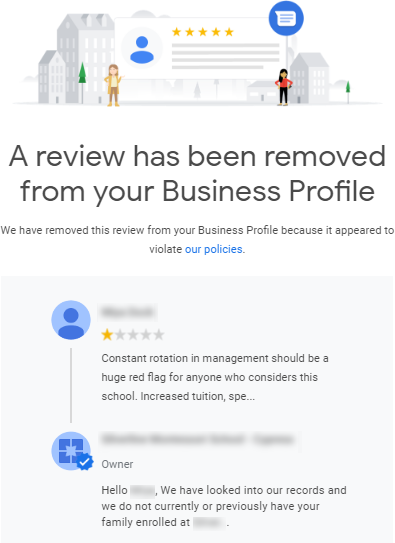
WILL Google remove every review you report? No – not even close. What hurts your business doesn’t hurt Google’s business. For the same reason that Google didn’t auto-filter the review right out of the chute, the chances are high that Google doesn’t consider the review unfair enough to remove it manually after your reporting it.
What does all of that boil down to? Two things:
You can go ahead and flag reviews that you already replied to. Of course, one possible danger is that the reviewer writes you another, angrier (or more bogus) review on Google Maps or elsewhere (or both). In general, I’d say that’s an acceptable risk. You can reply to damaging reviews even if you’ve already flagged them. You’re not making the review stick by responding to it. Does your response tip the scales at all, so that the review is more likely to stay put? That I do not know. I know only that Google may remove a review that’s been replied to.
How much success have you had any in getting Google to remove reviews of your business that you replied to?
How about reviews of other people’s GMB pages – reviews that they replied to and that you reported?
Any tips?
Leave a comment!
P.S. Do you know of anyone who’s already written on this (so I can give any due credit)?


On your way to your seat at the Local Feast, they follow you around like a bad smell. You toil to build a great page or resource on your site, and two days later they’ve copied it. You put research and brain cells into your title tags, internal links, GMB categories, and citations, only to spare your competitor all that effort. You get hard-earned reviews from happy customers, and then your competitor’s “customers” happen to write reviews on the same experiences. In addition to stealing everything but your cattle, they may spam the map and diss you whenever anyone is listening. Google won’t do much about any of it.
Copycats can get far, but only so far. It’s like in chess, where a bad player can copy a grandmaster’s every move until the game-ending move. In general, competitors who rip off your local SEO strategy will stop only once it backfires or otherwise stops working. Between you and them, it’s a war of attrition. You can outlast them. The only question is how much they bleed out of you in the meantime.
What many business owners and SEOs don’t seem to realize is that, although you can’t stop competitors from ripping you off, you can make their strategy much less effective. You do that by putting extra effort into certain parts that competitors can’t haul away – what I like to call “protective moats” around your business.
What are some of those protective moats? Here’s what I would consider the short list:
Your best links. Even if your competitors know of the specific good links you have doesn’t mean they (a) know how you pulled them off, (b) would be willing or able to put in the work you did to make those links possible, or (c) would see the same results. Of course, cheap-o directory links or links that require nothing more than payment/donations/dues are easy for your competitors to replicate (not that they’ll help either of you much). But your finest, hardest-to-get links? You probably have at least a few that took you (and maybe a helper) serious work to get, or that were the byproducts of years of work that you did without even thinking of the link. Your competitors would have a very hard time landing those, and collectively they’re probably one of the major factors that have helped you in the local search results so far. Your offerings: services, products, or treatments. Just as some competitors are too lazy to market without ripping you off, they probably didn’t learn their trade as well as you have, and therefore can’t help customers/clients/patients in all the ways you can. You offer services or products, or perform treatments, or handle cases that they can’t. Is it possible they could claim to offer those things and then do a bait-n’-switch on customers? Yes, but then they’ll lose business, get torched in the reviews, lose more business, divert energy away from marketing the services they do offer, and possibly get into legal trouble. The fulfillment part matters. Meanwhile, your great range of offerings will help your visibility for niche or long-tail search terms, on top of giving you extra side-door ways to rank for the broader, most-competitive terms. (Relevant post: “Spin-off Pages: a Bazooka for Your Local SEO.”) “Practitioner” or “department” Google My Business pages. If you’re a dental practice with a pediatric dentist, that dentist can have his or her own GMB page. With a little work on it and more work on the site (particularly on the landing page), that GMB page can rank for a whole range of “kids’ dentists” terms. The dental practice without the pediatric specialist has no such advantage. The same is true if you’re a law firm with multiple attorneys, each with somewhat differing specialties, and one attorney specializes in immigration law: He or she can have a GMB page that ranks for “immigration lawyer” terms on top of whatever terms the main practice’s GMB page (or other attorneys’ GMB pages) rank for. If you primarily sell widgets, but you also have a distinct area of your store where you repair widgets and another where you rent out widgets, then one or more of those could justify your having an additional GMB page for each department. Unless your competitors have the same kind of staff or the same department, they couldn’t have those additional GMB pages – or the additional visibility. Your location. Even though it’s not hard to create and verify a Google My Business page at a bogus address, it may be logistically impossible or prohibitively tough for your competitors to verify GMB pages at your location. Even if they could get their own map pin right in your building, there is a good chance they’d be filtered out of the local map. Awards, certifications, and publicity. Certain distinctions often bring with them visibility for you on sites that may be big in your industry or your local market, and that themselves rank well in Google. They may also bring you good links, referral traffic, unstructured reviews, bragging rights, and branding power, which often the raw materials of effective SEO. The fruit salad you earned may be the results of focused and intensive work, or the results of many years in the trenches. Your competitor can start at the beginning, the way you did, but because a third party had to give you your props, there is nothing for a competitor to grab. Videos. If a video features your smiling visage, shows your business or branding, features your customers, or in general demonstrates how great you are, not only is it hard or impossible for a competitor to lift or edit, but also no competitor would want the video that results. Videos are inherently hard to rip off, which may be one reason that even all these years it’s still not all that hard to get them to rank for pretty competitive local search terms. (Of course, the main benefit of a good video is to make your site more persuasive by embedding it on your site.) Persuasive reviews. Competitors can easily write or buy sock-puppet reviews, or fake their reviews in other ways. But those reviews usually won’t appear credible even on the surface, and will look even shadier when would-be customers look up who the “reviewers” are – none of whom seems to be a real person whose life can be researched a little through Google-fu. Competitors can copy reviews, but they can’t copy authenticity.
—
There are always ants at a picnic, and you can assume some of your food will disappear or start marching away. But if you pack enough food that the ants can’t or won’t eat, you’ll have plenty for yourself.
What are other aspects of local SEO that competitors can’t pick up and drag off?
Any first-hand stories about competitors who aped your strategies?
Leave a comment!


Confused users don’t spend moneyYour search marketing needs to thread in your brand’s messaging, targeting, design, and overall experience to ensure trust, clarity, and eventual salesSEO pioneer, serial entrepreneur, and best selling author, Kris Jones helps you weave a tight SEO and search marketing strategy before 2022 ushers in
If you spend enough time in the digital marketing space, even if you focus on just one area of it, you’ll eventually catch wind of the intersection of SEO, paid media, web design, and link building. There’s no avoiding it since all these areas run together to ideally form a strong online presence for a business. Within that context, if you’ve ever been the one to devise a digital strategy for yourself or your clients, you’re probably familiar with the types of market niches that would push a business to focus more on SEO or paid search marketing.
SEO is obviously a fantastic tool for just about anyone, but don’t discount the power of paid media. Each has its pros and cons, and when done the right way, neither is going to hurt you.
What will hurt you, however, is making mistakes in your efforts and then letting them go for a long time. Weak points in your SEO and paid media can be tricky things. They can harm your digital presence in the long term and yet be difficult even to detect unless you really know what you’re doing.
With the home stretch of 2021 right around the corner, now is the best time to stitch up those holes in your search marketing for 2022. Here are four tips for cleaning up your SEO and paid media marketing.
SEOs know the old story, but here it is again for anyone who doesn’t. Ten to twenty years ago, it was a popular practice to keyword-stuff on web pages. That just meant overusing a certain keyword on a page in an attempt to get Google to rank the page more highly.
In 2021, we know this is a bad practice because it doesn’t help users to answer their questions. What answers questions for online users today is content that discusses popular topics rather than just keyword-spamming.
You can use popular topic-research tools such as BuzzSumo, Answer the Public, or Semrush to find topics relevant to your desired industry niche. Then, do your own research to generate content that’s useful. Always think of the user first.
Keywords still have their place, though. Google needs to match up queries with content, and the content that makes the smartest, most useful, and natural use of keywords will tend to perform better. Content needs to have keywords in its headings and also use naturally within the body. But don’t think that you need to overuse keywords or focus your content completely around the keywords. Instead, determine the intent of the keywords and align that with your topic research to create killer content that ranks.
When your search marketing includes paid media, too, you have a whole other set of guidelines to follow. Again, everything you do should be with users in mind. Put yourself in their place. How would you respond to this ad if you saw it?
Then, click through to the landing page to make sure everything still makes sense. The thing is, here is where PPC specialists can fail if they aren’t careful.
With paid media, you’re using ads to get people to do things. That’s what you have available: words and images on little square ads on web pages or paid search results on the SERPs.
Sounds straightforward, right? As long as you do your research and get the ads’ messaging correct, you should be golden.
Except you can go way wrong if your messaging isn’t consistent across the entire paid search journey. Your landing pages need to contain the same type of messaging as your ads. They need to reference the information users saw when they first clicked the ad.
That shows continuity across your paid campaigns. Without that continuity, without landing pages that reference offers or claims made in ads, users will be confused. They’ll wonder if they clicked the wrong ad or got taken to the wrong website.
And confused users don’t spend money.
Think about it this way: it’s been estimated that it takes between five and seven impressions before one user remembers a brand. Five to seven! It can be challenging enough to reach those numbers but imagine if you tried to get there without brand consistency. You’d be setting yourself up for failure, plain and simple.
The solution is once again to think like a user. Go through all the elements of a paid search user’s journey. If the messaging and branding flow logically and actually make sense, you may have a winning campaign on your hands.
I said at the outset that the different areas of digital marketing all have the potential to intersect and flow together. Here is where SEO and web design meet up: website UX.
SEOs can spend all day researching keywords, writing content, optimizing meta tags, and building backlinks, but users probably aren’t going to do what you want if your website has a terrible layout and design, not to mention if it isn’t optimized for the mobile experience.
But don’t just listen to me – read the numbers. According to Intechnic, 67 percent of online users say that a badly designed website negatively affects their impressions of a brand. That is a huge figure, to put it mildly.
When Google’s spiders crawl a site, they do so logically, as a human would. That means the main navigation needs to set out the content your site has and be clear about where users can go to find certain information.
Now, what qualifies as a “good” layout? It’s simple when you think about it, and yet so many websites struggle to do it. The main navigation needs to show users all the vital areas of a site. Whatever business you’re in, your nav should show your main services first, followed by a blog if you have one (you should), an “about us” section, and a contact tab.
That setup right there covers all the main points that you’ll need to keep users engaged. Now, how everything else breaks down from there is up to you, but again, keep it logical. Your main services tab should have a submenu of all your main services, your locations tab can break down to show your different business locations, and so on.
Also, you absolutely cannot forget accessibility when you’re talking about website UX today. Accessibility, of course, is the capability of any piece of website content to be consumed and understood by people with a range of physical or mental disabilities. Not only is this simply a good business practice, but it’s also just inclusive and courteous.
Website accessibility includes considerations such as making content available to the visually and hearing impaired, ensuring your web pages are navigable with a keyboard only instead of just with a mouse, and choosing colors that don’t clash so color-blind people have no trouble reading your content.
Makes sense, right?
It’s important that it does make sense because if neither human users nor Google can understand how to navigate your website, you probably won’t rank for your desired keywords.
If you’re a business owner and are doing your own digital marketing, or if you employ one (possibly overworked) specialist to do it for you, it can be more than a little tempting to engage in the “set it and forget it” mindset.
Small to medium-sized businesses have so much to do just running themselves that putting sufficient effort into digital marketing can seem like too much of a stretch.
You may think that you’ve come up with a pretty effective PPC ad campaign that contains all the right visuals and messaging and hits all the right audience marks. And maybe you have, for now.
But you can’t set and forget anything in PPC or digital marketing more generally. Trends change, markets shift, consumers move on. You have to check in on your ads’ performance over time to see if you’ve recently fallen flat. Because if you have, then you’re wasting a lot of effort maintaining ads that aren’t converting.
Instead of letting things go like this – put the time into analyzing your ads’ performance, particularly in the time immediately following the start of the campaign. You want to ensure things are running as you predicted and tweak them if they aren’t.
While you’re at it, set aside some time to research how you can optimize your PPC campaigns’ resource consumption. The best campaigns are obviously the most efficiently performing ones, and so how can you do better?
Try reworking your ad copy. It sounds simple, but as you know, more relevant ad copy drives click-through rates and Quality Scores. And high-quality scores reduce your cost per click and cost per conversion.
Another money-worthy avenue you can take to hone in on your ads’ efficiency is to use dayparting and geolocation together. Dayparting will schedule your ads to appear at certain times of day, while geolocation will show your ads only in certain places.
This is particularly useful for local businesses that have brick-and-mortar locations and want to get customers through the doors.
This takes plenty of audience research to get it right, but it’s a smart and common-sense way to optimize the resources you’re using on your PPC ads.
A stale PPC campaign has the potential to be one of your biggest search marketing holes in 2022, so don’t wait on this one.
There truly is no time like the present for fixing your search marketing loopholes. Any mistake that’s out there for any length of time is probably going to hurt you. But with the second half of 2021 already here, lots of businesses are setting their sights on 2022.
Become one of them. Follow these pointers to get ahead in your search marketing efforts, and it could make all the difference.
Kris Jones is the founder and former CEO of digital marketing and affiliate network Pepperjam, which he sold to eBay Enterprises in 2009. Most recently Kris founded SEO services and software company LSEO.com and has previously invested in numerous successful technology companies. Kris is an experienced public speaker and is the author of one of the best-selling SEO books of all time called, ‘Search-Engine Optimization – Your Visual Blueprint to Effective Internet Marketing’, which has sold nearly 100,000 copies.
Subscribe to the Search Engine Watch newsletter for insights on SEO, the search landscape, search marketing, digital marketing, leadership, podcasts, and more.
Join the conversation with us on LinkedIn and Twitter.
The post Now is the best time to stitch your search marketing loopholes before 2022 appeared first on Search Engine Watch.
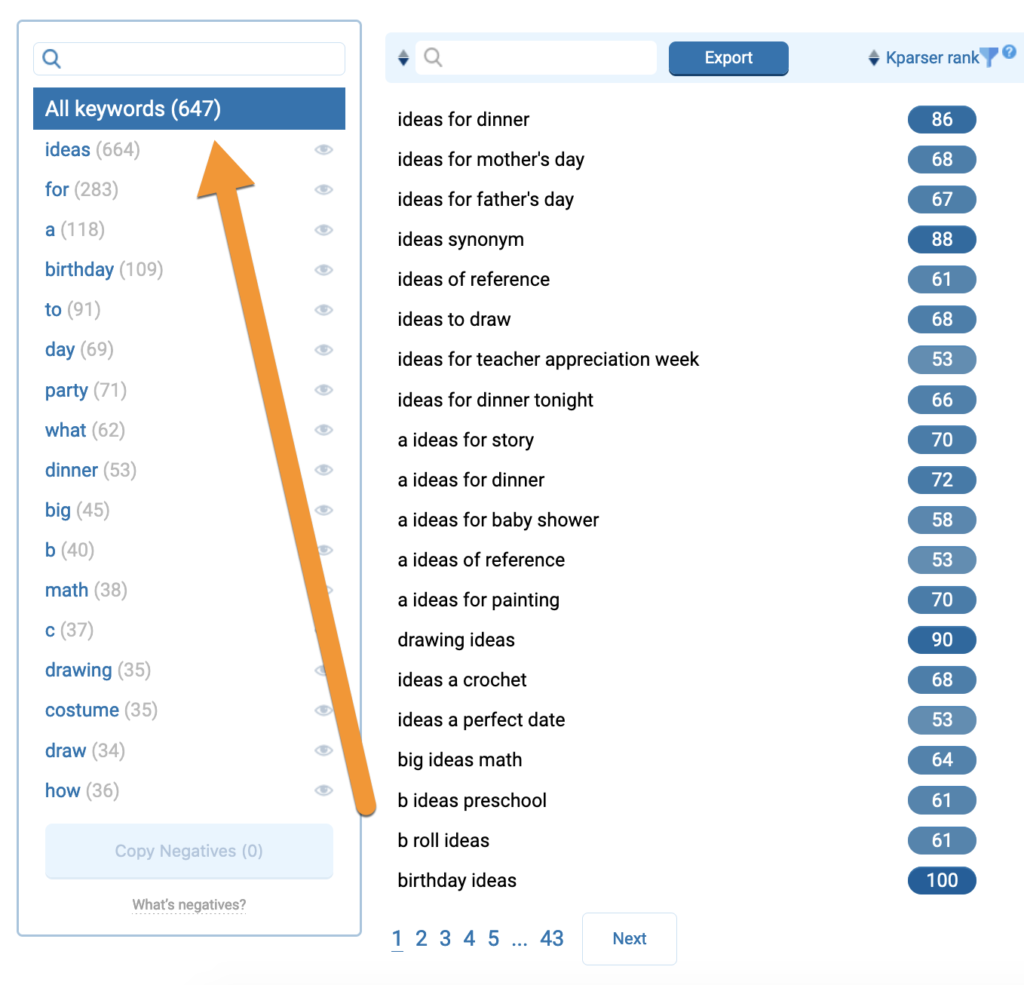
Keyword research is at the heart of understanding where your business stands and what your end-users expectSurveying or monitoring your analytics is a great way of listening to your customers or readers for effective content ideasSeasonality is a great way to find fresh content ideas by finding angles where your primary topic overlaps with seasonal interestsCollaborate and meet real people – use every opportunity (events, meetups, live sessions) to talk to people and listen to what they’d be interested in consumingUse “question research” to understand the existing information gaps in the marketRe-package your old, better-performing content into new (updated) assets
If you feel like everything has already been written and you have no idea what else you can write about, here are six content ideas for you that help you come up with valuable and engaging content this year:
Keyword research is not just for SEO! They can give you in-depth insight into your audience’s interests, questions, and struggles. Research and address them in your content.
The key is to try a new tool from time to time. Why? Each tool uses a different data source or a different output or a different way to organize those keywords. Any of these will be enough to give you lots of content ideas.
Luckily, we have quite a few tools to choose from.
This tool will give you pretty much everything you need to create a good topic list. Or at least point you in the right direction. Look at the left-hand channel to find popular concepts around your main topic and build your content around those!
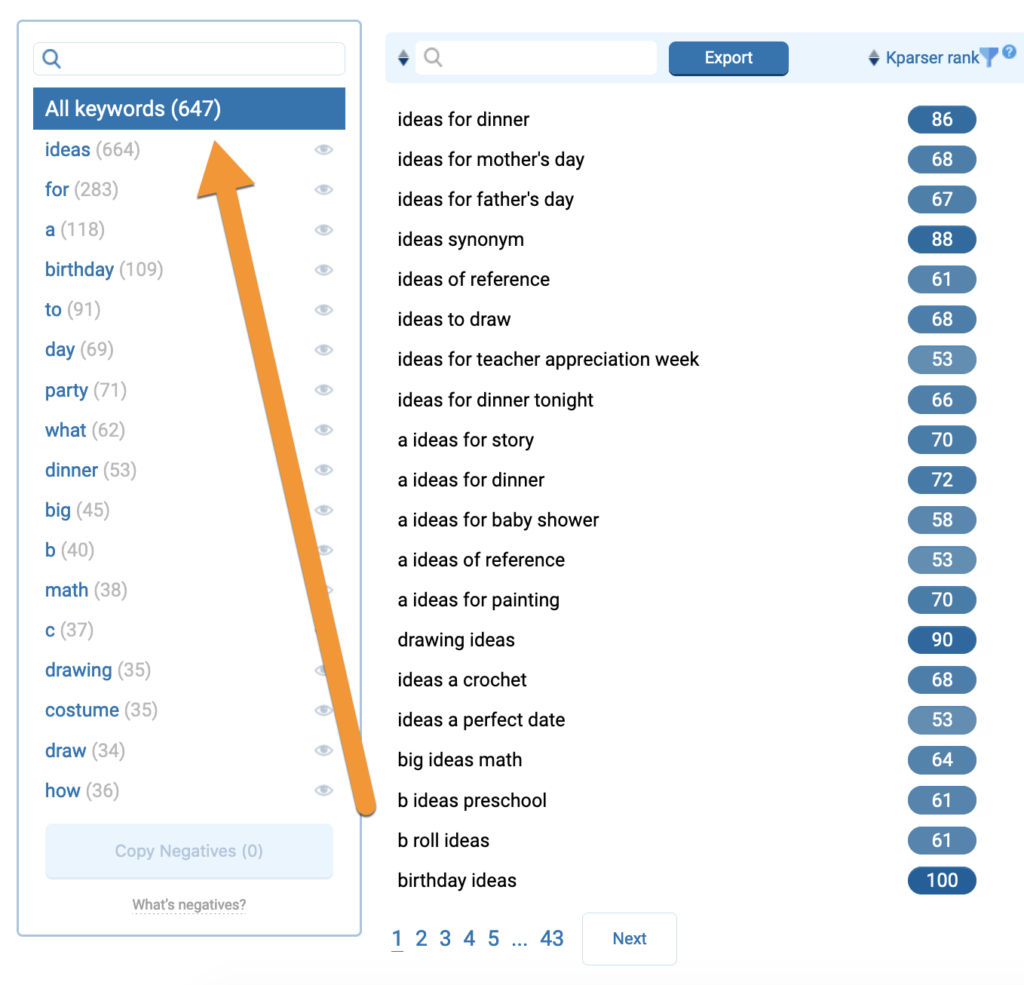
Source: Screenshot by the author
Kparser offers a premium version for $69 a month but I’ve always been using its free version which is great!
KeywordTool.io allows access to lots of data sources, including Google, Youtube, Amazon, Instagram, and Twitter.
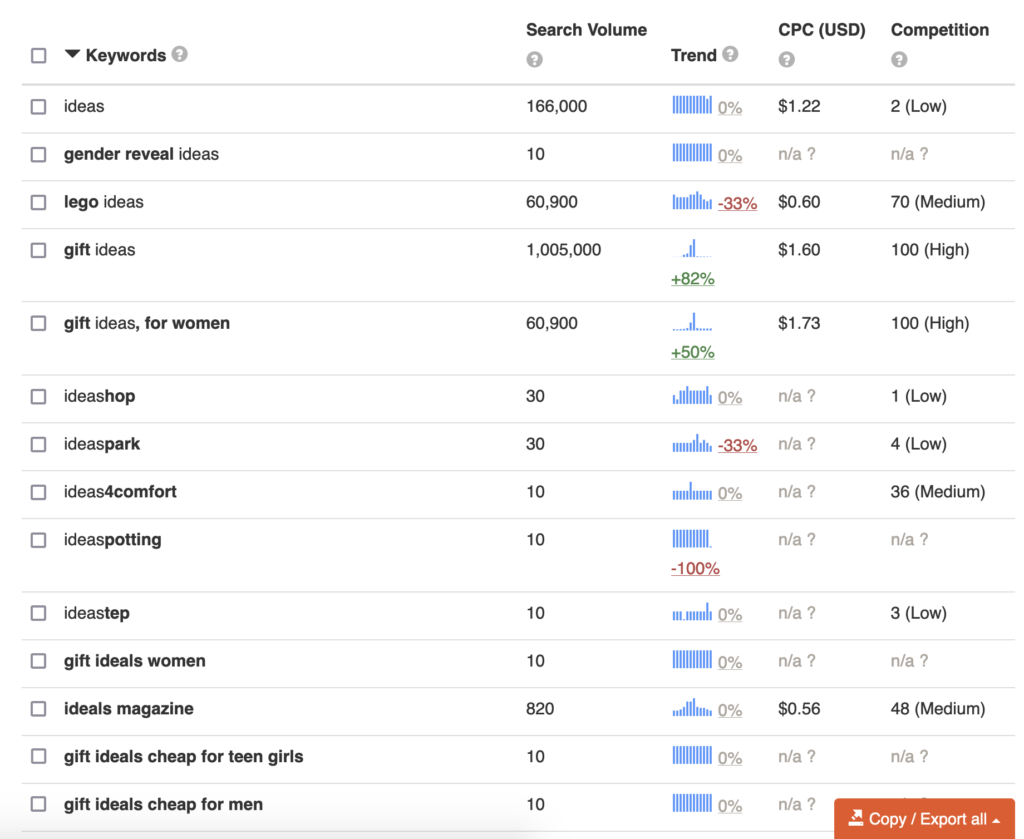
(Content ideas sourced from Amazon)
Source: Screenshot made by the author
The tool will give you lots of ideas for free but to see each keyword analysis, you need to upgrade to one of the listed plans.
nswer the Public
This one you may not have heard of. It features a man called ‘The Seeker’, who impatiently awaits your questions. You put in keywords or phrases, he suggests some interesting topics.
Apart from being a great keyword research tool, this one is also great for question research (see my #5 tip on the list!) Using different ways to group and organize your keyword lists will likely uncover more ideas. These grouping techniques include keyword clustering and semantic research.
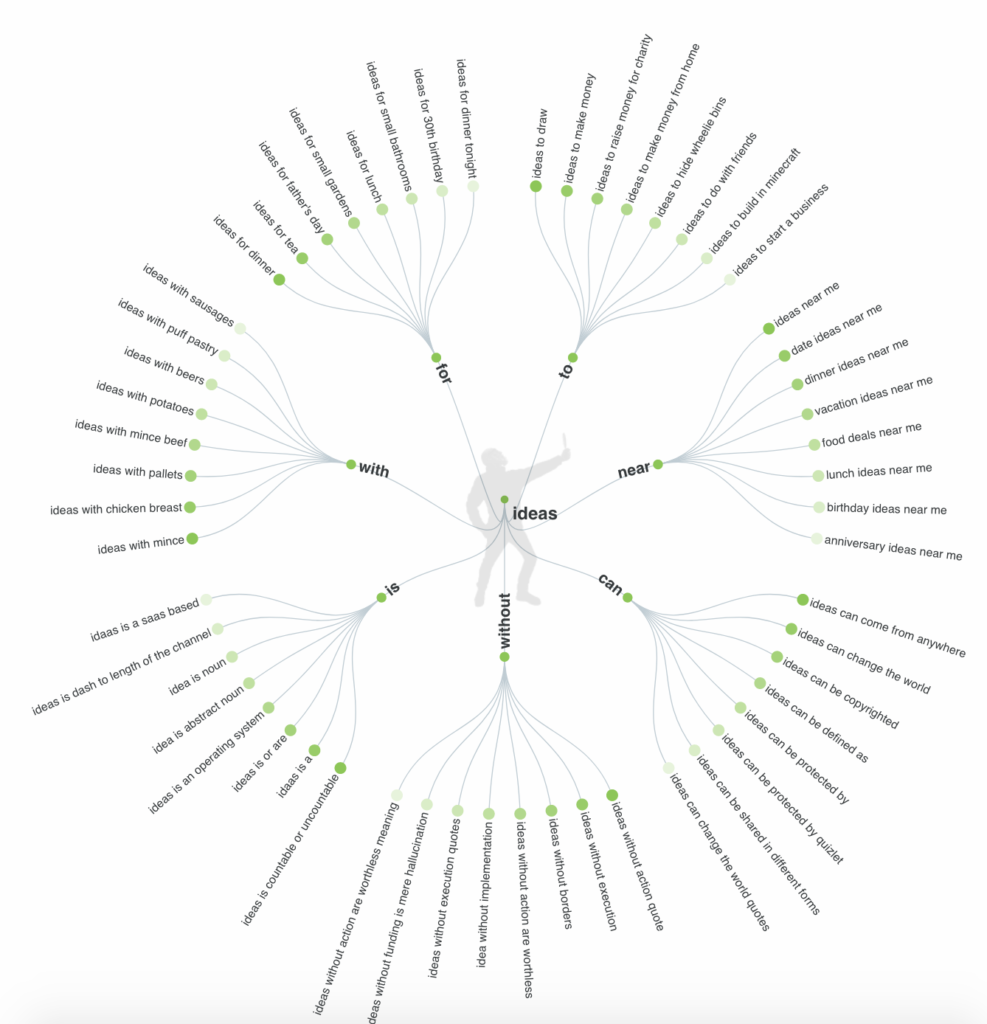
Source: Screenshot by the author
Answer the Public is freemium and comes at $79/month minimum if you pay for a year, but frankly I’ve never had to upgrade as the free version is simply awesome!
You know who you really need to listen to. Correct, your current and future customers. You want your content to make a difference for your bottom line, not just bring your word out there, no matter if anyone is there listening or not.
You don’t just want to be heard, you want to be heard by your target audience.
You can even gamify that process by building up your surveys with visualization tools, here are some extra tips on that.
You can offer a good mix of generic questions (like, ask about their lifestyle) which would help you build up your customers’ personas and target them better. Then come your brand-specific questions:
“What questions did you have when browsing our services?” “Were they sufficiently covered on the site?”
The latter will help you improve your site performance too.
The cool thing is that you will also be able to use your survey results in site content and articles, making your site intent-rich, trustworthy, and linkable.
It’s also a wise idea to set up a well-defined routine to help you record your customers’ questions as they come. This will help you in both content planning and social media goals.
Slack is a nice tool to help your in-team communication and idea-sharing. Simply set up a separate Slack channel and encourage your customer and support team to send your customers’ questions there as soon as they come across any.
Using your web analytics is another way to listen to your customers and readers. Finteza is a great solution to better understand which content and on-page elements your site users respond to best. It supports a variety of events including mouse-overs, clicks, and downloads allowing you to measure which content does a better job engaging your readers:
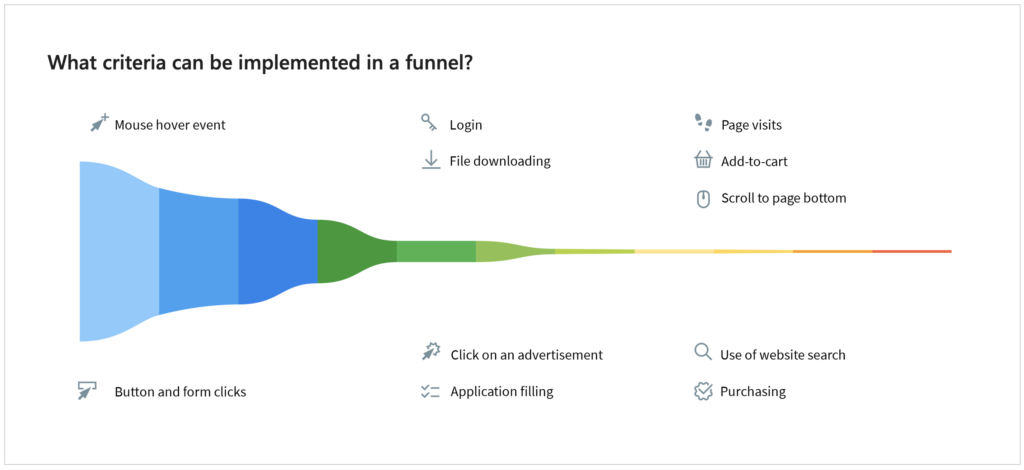
Source: Finteza
There are holidays and seasonal trends to include in your content editorial plans. When you catch a trend, there’s always a huge boost of interactions, new followers, and clicks.
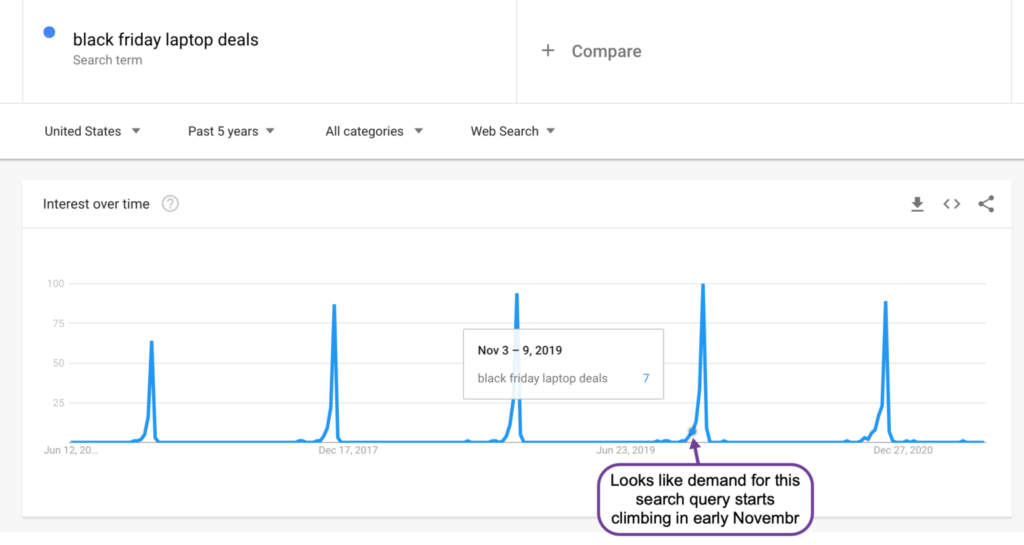
Source: Screenshot by the author
The great thing about seasonal trends is that you can plan your editorial calendar months in advance because they are easy to predict and repeat yearly. This means you’ll be able to re-use your calendar as a reference point to structure your seasonal content strategy and improvise for maximum success.
Simply sit down and plan your content assets for upcoming big holidays, seasonal events like spring cleaning season, summer holidays, Amazon Prime Day, and other noteworthy days that are relevant to your target customers.

Source: Screenshot by the author
You can use Google Spreadsheets to create your content roadmap. To better focus on ideation and get more inspired, I usually start with planning my seasonal content using a printable calendar which you can easily find using these steps.
There are handy calendar apps that can even integrate into WordPress to keep track of those holidays you may want to include in your social media editorial plan.
You can schedule social media updates as far as one year ahead to make sure there’s always something going on your brand channels no matter how busy you get.
We have a tendency to look for our inspiration online because we are targeting an internet-based audience, which is totally understandable: you can discover so many wonderful topics on the web. It just isn’t the only place we can look and purely searching online actually limits our scope, and so our returns.
The most popular piece of content is one that comes from the real world. People love personal stories!
Go out into the real world. Seek out events in your industry, or things that are tangentially related. Discover how everyday experiences connect to your niche and use your social media channels as a platform to explain and share with others.
Get out of cyberspace and into meet-space!
A good way is to engage with your local community (now in a safe and socially distanced way!)
This serves as a great way to understand the pulse of your audience/target customers, their intent, and personal experiences that impact their decisions. Plus, you also earn a chance to introduce new people to your brand.
You can also connect with other local brands, businesses, and business owners and potentially work out some topic ideas that way.
Question research offers a few important marketing opportunities:
Questions give you lots of insight into what your target audience is struggling with and how to best help themQuestions are your best content ideation sourceCovering niche questions online opens up more organic search visibility opportunities including getting featured and ranking in “People Also Ask” resultsAsking a question on social media is one of the most important ways to increase your social media engagement because whenever they see a question mark, people have that natural reflex to stop and find an answer
So ask questions on social media often and engage with answers you receive.
If you are open to trying tools to bolster this exercise, Text Optimizer is a smart option. All you Just type your keyword into its “Topic Ideas” section and it will generate a list of topic ideas for you:
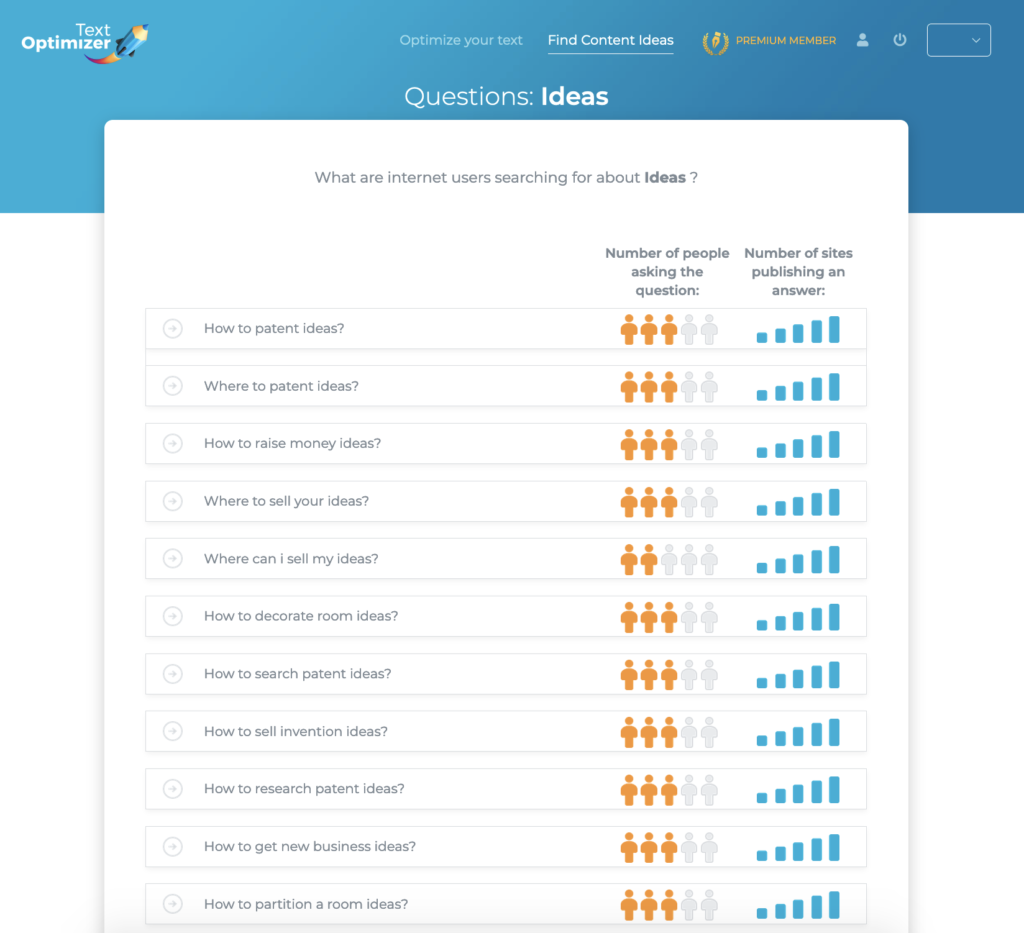
Source: Screenshot by the author
Every question is rated based on how many people are searching for it and how many sites are covering it – giving you a clear analysis of demand vs competition which informs your decision making.
The tool is paid and I am not aware of any alternatives. But the good thing is, question research will be mostly free. You will get some content ideas without the need to pay or register an account.
Quick tip: If you install their Google Chrome extension, most of that analysis will come for free as long as you use Google Chrome.
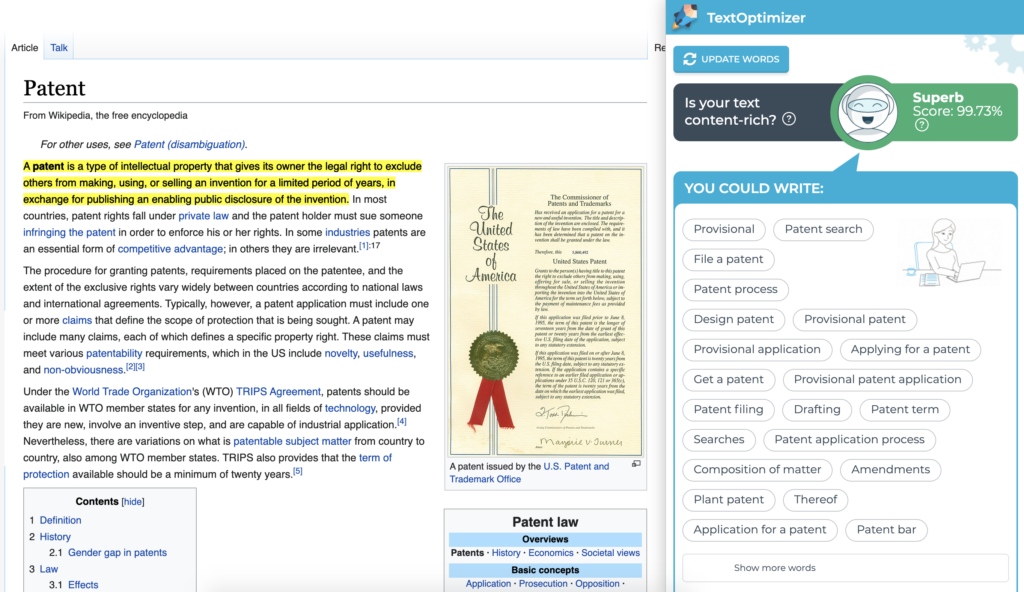
Source: Screenshot by the author
Right off the bat, re-packaging content is going to be the best weapon in your arsenal. It takes what you already have and makes it stretch, getting more out of every piece you write. A lot of those prolific writers are using this tactic, albeit at its extreme. That is how they manage to get so much out without others writing for them.
So what does re-packaging content entail? It is creating new content directly from the old. Some ways to do that are:
Collecting articles into an ebook to give away on your site (As a bonus, this would also make a great lead magnetCreating a webinar with the information you have writtenTurning your content series into a (mini) email courseCreating newslettersRecording a podcast with the old post contentShooting a video with the old post contentConverting info from posts into infographicsMaking a Slideshare presentation with condensed slidesWriting new posts based on small details mentioned in old posts that have been expanded
These are only a few examples, but you get a general idea. A piece of content should never remain on its own without some form of recycled item coming out of it.
Looking at that list of ideas for re-packaging old content, did any of them stand out as forms of media you have never tried before? It may be time to start expanding what you create and produce something brand new.
This will attract a new kind of audience, one that is drawn to the media in question. Do you usually write blog posts? Start making infographics or videos. Never done a Slideshare slideshow? Consider it now, and see if it gets any bites.
You will be able to recycle your content better this way, and it will keep you from being burnt out. That will inevitably have an impact on the speed and quality of your content creation.
Content ideation isn’t easy and moreover, it is a continuous struggle. Let’s hope these ideas will get you out of that writer’s block!
Ann Smarty is the Founder of Viral Content Bee, Brand and Community manager at Internet Marketing Ninjas. She can be found on Twitter @seosmarty.
Subscribe to the Search Engine Watch newsletter for insights on SEO, the search landscape, search marketing, digital marketing, leadership, podcasts, and more.
Join the conversation with us on LinkedIn and Twitter.
The post Six content ideas to supercharge your marketing in 2021 appeared first on Search Engine Watch.


All the copy and strategic use of keywords in the world will not impress search engines if your web design is not fit for purposeThe design of your website or web app is linked intrinsically to user experience, which in turn impacts your Google quality score and SEO performanceWebsite design must drive users from A to B without any unnecessary steps in between – while retaining relevant copy that ties in with your SEO strategyReview your website design when considering your SEO strategy KPIs – a drop in traffic may be due to a substandard or outdated layoutDo not neglect copy, as UX meta copy will improve your CTR on paid advertising. In turn, though, ensure that your website’s design system is strong enough to obtain a suitable quality score and keep your Google Ads spending within budget
In many respects, a website is the home of your business on the web. To this end, it’s perhaps fitting that creating a website is not unlike building a house. To achieve your intentions, you’ll need to establish solid foundations before commencing construction. When it comes to building a website from scratch, that means engineering your design systems and templates to maximize SEO potential.
Many businesses emphasize content and keywords in their SEO strategy, with design becoming an afterthought. To return to our housebuilding analogy, that’s like laying a solid roof upon unstable walls. There is no denying that superior copy is critical to enjoying a successful approach to SEO. Even the most gifted writer cannot overcome substandard web design and user experience, though.
No website, no matter how well designed, will remain the same forever. Therefore, websites and web apps need to be regularly audited, refreshed, and even wholly redesigned. Such steps are the only way to retain your target audience’s interest and ensure that you remain one step ahead of Google’s ever-evolving SEO algorithms.
At the very least, a website redesign is necessary every three years. If you diagnose a plummet in traffic, it may become essential sooner than this. Take a deep breath, review your data, and ascertain what is to blame for your drop-in visitors. If you suspect that your web design is the issue, a wait-and-see approach will not yield results. Your traffic will continue to drop, and the longer you wait to resolve the problem, the more mountains you will need to overcome.
Now, as anybody that has ever built a website from scratch will know, the task requires two things in abundance – time and money. Both are precious commodities for a business, especially an SME.
Alas, all websites periodically need a little tinkering under the bonnet. If you have established a design system, this will be significantly less disruptive. Effective website design systems ensure that your tech team or design agency has a firm and reliable blueprint to work from, and everything is in its place. Essentially, any work on your website is editorial rather than creative. As a result, you’ll enjoy positive implications on labor intensiveness and expense alike.
Above all, design systems create a positive user experience. If you expect to have any measure of success with your SEO strategy, superior UX is non-negotiable. 21st Century consumers have more choice than ever before, and patience is in short supply. If your website design system does not meet users’ needs quickly and efficiently, visitors will stay away – and Google will sit and take notice.
SEO and design systems initially appear to be opposites. Web designers focus on making a site look fabulous and providing accessible, fluid navigation. Copywriters ensure that the content meets a users’ needs, convincing them to follow the steps laid out in web design. In reality, these two disciplines are entwined when it comes to maximizing SEO.
First thing’s first – if you redesign a website without factoring your SEO into the equation, disaster awaits. Forget to apply 301 redirects, and Google may wipe your entire SEO strategy overnight. If all else fails, at least take advantage of UX microcopy to create engaging, interactive 404 pages. Ensuring that a redesigned website can still find high-performing pages is the only way to maintain SEO and SERP progress, though.
In addition, consider the impact of design on your SEO. Consider how mobile-friendly your design system us, and what coding you use. Anything more complex than industry-standard CSS or HTML may capture the imagination of a first-time user but can be considered a novelty. It may be challenging for readers to understand how to navigate such a site, and you’ll struggle to optimize your content. These issues will have a knock-on effect on your page ranking.
As discussed, any business or individual must update their website from time to time. Even if your site is still pulling in traffic, there is no harm in making tweaks. It’s much easier to keep traffic flowing than to regain loyalty and interest from lapsed consumers.
When reviewing your website’s design templates, ensure that you consider the following to maximize the impact of your SEO strategy.
First and foremost, ensure that your website design templates clearly and directly explain your brand values and mission. Imagine that every click on your site is from a first-time visitor. Do they know what you can offer and how you’ll do so? If you cannot convince a user that you’re worthy of their attention in less than 15 seconds, they’re likely to click away and be lost for good. Google will acknowledge this bounce rate and adjust your quality score accordingly
As we have mentioned previously, all websites need to undergo periodic renewal, including your competitors’ online presence. Be sure to constantly check in on what your rivals are doing, especially those that seem to enjoy excellent SEO performance. Take your findings and build upon them, whether that’s taking a skyscraper approach to SEO copy or adjusting the layout and design of your site to meet the industry gold standard.
Before you embark on any kind of website redesign, factor all these matters into your thinking. If you create a website design system that meets all criteria, any future adjustments will be considerably more straightforward.
As well as keeping an eye on your competitors, think about industry trends. While every consumer is unique, large groups can be relied upon to embrace a herd mentality. When building a design system, ensure that you can showcase any social awareness campaigns. Be ready to alter payment methods if a new financial platform takes the world by storm. Consider introducing one-click models to reach pages if these become popular. Few consumers will place their trust in a website that is deemed archaic and out of touch with contemporary tastes and expectations.
Website design packed with bells and whistles can look spectacular on a large HD screen. Consider how your site will perform when squeezed into a 5.5″ smartphone display, though. More and more people are eschewing desktop browsing for a portable alternative, which must factor into your design template. Failure to cater to the mobile market will place you firmly in Google’s bad books.
Arguably the most prominent concern of them all – you must ensure that your website design offers an enhanced UX for your visitors. Get people from A to B with a minimum of fuss. Do not be tempted to stuff your site with additional pages, creating more links in a chain to flex your copywriting muscles or cram in more advertising. Speed and simplicity will always win out.
Is your website’s design system engineered in-house or through an external agency? It’s better to bring in outside help if you are not an expert in this field. If you do so, however, ensure that you understand how to make any changes yourself. Fast action may be required, and you will not want to be at the mercy of a third party’s availability.
Meta text and tags will not directly influence your page ranking with Google, as they do not influence a quality score. Appropriate meta tags on images can help images be sourced by search engines, though, as well as enhancing UX for visually impaired visitors.
Another consideration when building a website design system for your SEO is the capturing of first-party data. In 2021, the real currency is information. By understanding your target audience and obtaining data that they willingly provide themselves, you tailor your offering to those likeliest to use it. Do not neglect opportunities to source this data for yourself – it will save time and money and ensure accuracy when building a customer profile.
Whether we like it or not, this is Google’s world, and we’re just living in it. Set up alerts and do whatever you can to stay one step ahead of any algorithm updates, whether major or minor. History is littered with horror stories of websites that lost four figures of revenue overnight due to traffic slumps following an algorithm update. While it’s impossible to predict what The Big G will get up to next, you can at least protect yourself by pre-empting changes.
For some websites, advertising is a necessary evil to maintain a revenue stream. Always consider the placement and style of advertising in your website design system. Static ads that fill a page or videos that slow down performance will infuriate users and lead to a high bounce rate. Google will also notice these issues and reduce your quality score accordingly. Slow loading speeds and an emphasis on advertising over quality content are both red flags.
Finally, think about how you will assess the success – or otherwise – of your SEO strategy. Is it time to update your choice of SEO tool? Think about the KPIs you measure regularly, and ensure your website design system supports such tools and plug-ins. There is little point in investing in SEO services if you are unaware of their performance.
As discussed, a gold standard copy will not supersede poor website design. However, this does not mean that you ignore your copy needs in favor of focusing on aesthetics. Relevance and information are just as crucial to UX as rapid negotiation of a website. Never lose track of the importance of Google’s algorithms, either. If you fall foul of E-A-T expectations, it can be challenging to regain your standing.
So, to answer the question above, copy is not more important than website design – but it’s equally critical. A well-planned website will attract attention but great copy will retain it. Copy alone will not dictate a stellar Google quality score but can bolster conversions and improve CTR on paid advertising. Such steps are vital when taking advantage of SERPs.
All of this raises an important question – what should come first when prepping an SEO strategy, copy or design? Returning to the housebuilding analogy that opened this guide, design is the sturdy, reliable bricks and mortar of a dwelling. Copy is the personal touch that makes a house a home and something uniquely your own.
If you were building a home from scratch, however, would you not feel strongly about ensuring it met your needs? You would ensure that the dimensions accommodate your existing furniture and that the blueprints provide enough space that you will not need to move any time soon.
If you have your copy planned out before creating a website design system, you will have a margin for error. You can tailor every step of the user journey to the text that you have prepared, and where necessary, streamline your content with the aid of data storytelling. Above all, you can adjust copy without too much fuss, adapting to the ever-shifting SEO landscape. A design system is considerably tougher to remold around your prose. Always keep this in mind when planning your website.
Joe Dawson is Director of strategic growth agency Creative.onl, based in the UK. He can be found on Twitter @jdwn
The post Design systems and SEO: does it help or hinder SERP achievements? appeared first on Search Engine Watch.
Did you miss our previous article…
https://www.61seoservices.com/?p=148
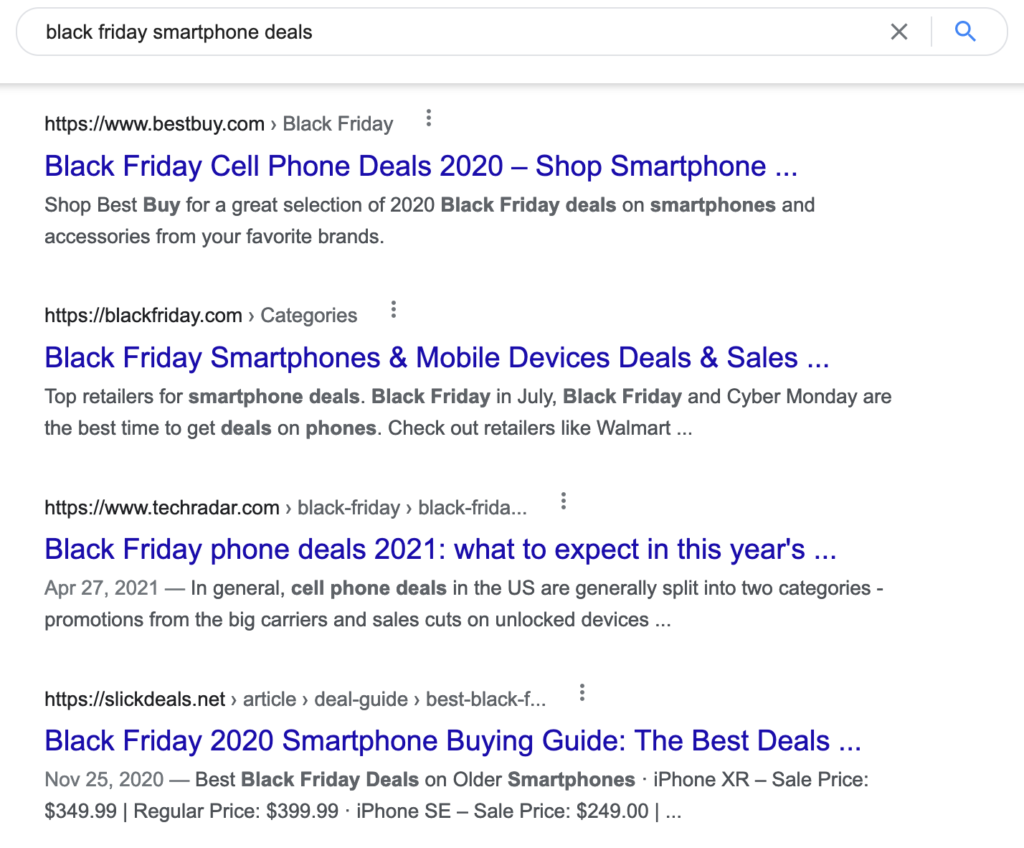
To ensure organic visibility for your seasonal pages, start creating, optimizing, and analyzing them nowStart creating, organizing, and scheduling seasonal content assets now for a head-start when it’s time to start focusing on driving salesEvaluate your past seasonal content performance to be able to recycle, update, and possibly even expand them into standalone projectsResearch your competitive tactics to evaluate how they utilize seasonality in their digital marketing strategyCreate a detailed editorial calendar to plan out all assignments and deadlines to “catch” the rising interest in seasonal content and deals
Summer is a slow season for many businesses, especially those in a B2B niche. If things are a bit slow for you now, here’s an idea – Use these quiet months to turn your next big season into a huge boost for your business. Here is how you can start preparing for your next big seasonal content marketing campaign now:
Do you have a page (or pages) offering seasonal deals, gift ideas, and special offers? The demand for this type of content may be seasonal but its rankings should be permanent. That’s why I always advise against removing these pages or even delinking them throughout the site.
You want those pages to always be accessed by Google for your rankings to be there when the searches start climbing.
If you cannot find your site ranking for your target seasonal queries, it is time to set them up even if the actual season is still months ahead.
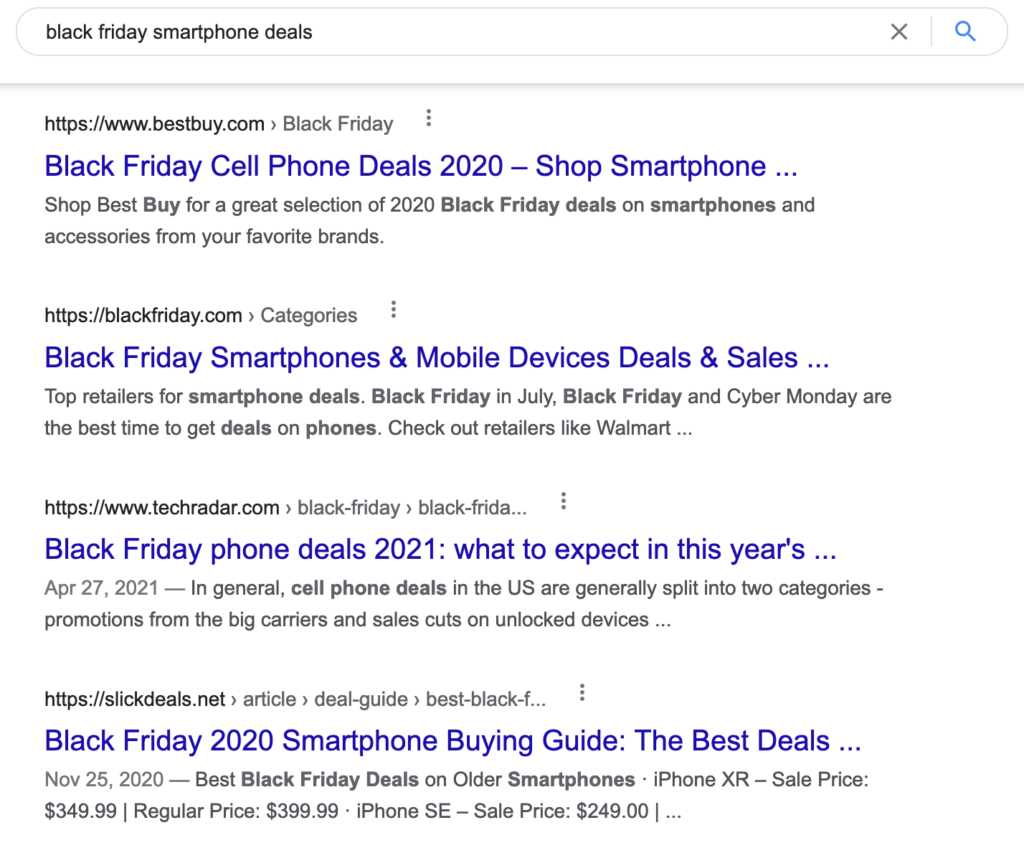
Source: Screenshot created by the author
Furthermore, Spyfu offers a comprehensive analysis of all SERP movements for you to identify important patterns and spot a competitor that was doing the best job retaining their organic visibility for seasonal search queries:
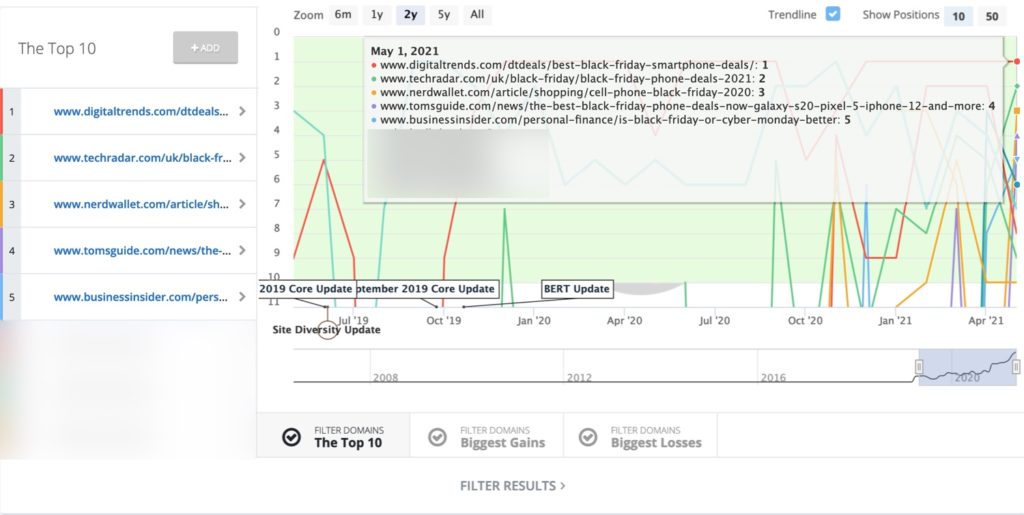
Source: Screenshot created by the author
Read more about this feature here
When it comes to SEO, seasonality can be tricky but it definitely needs to be planned ahead as organic SEO takes time to yield results.
Your high season is going to be a busy time for you and your team, so while planning your upcoming campaigns, start creating (and even scheduling) your content assets beforehand.
When brainstorming seasons content ideas, I always turn to Text Optimizer that does a great job suggesting related concepts and angles to focus on:
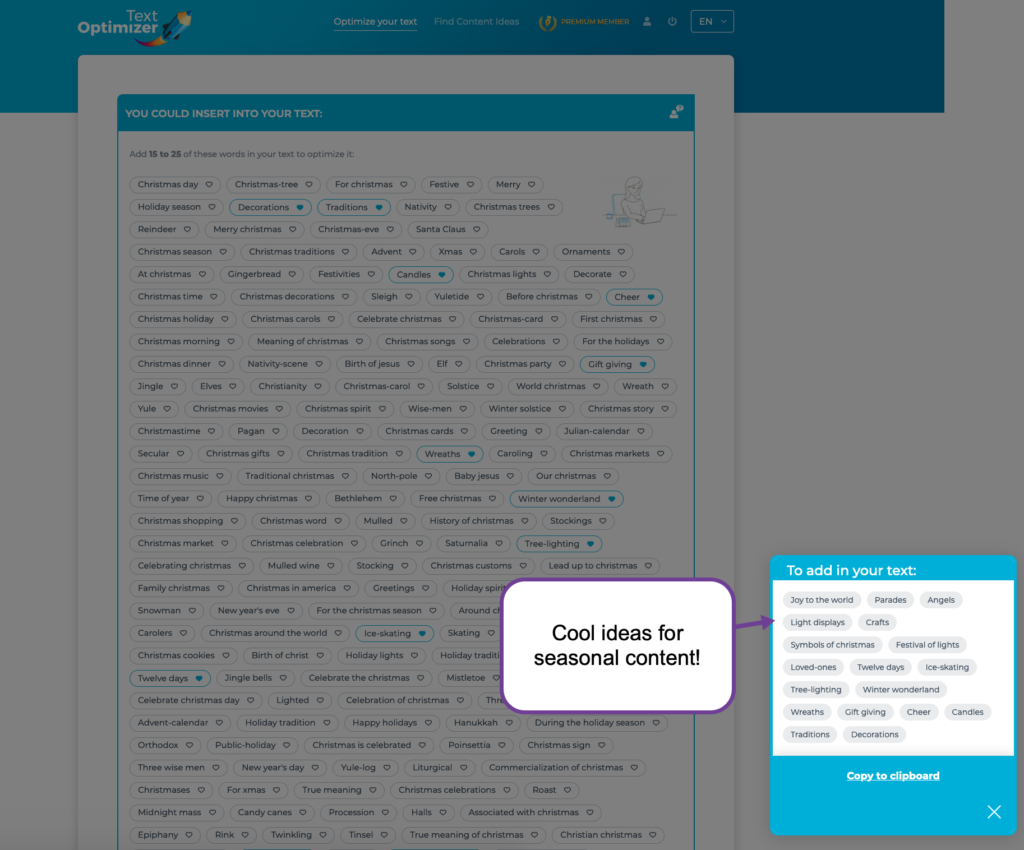
Source: Screenshot created by the author
The tool relies on semantic analysis
Content marketing involves a lot of channels, so the more you are prepared, the easier (and more productive) your seasonal campaign will turn out to be.
Furthermore, there are a few cross-channel content marketing tools that can help create and organize your seasonal content. For example, Boosted by Lightricks allows you to easily create festive videos in multiple formats:
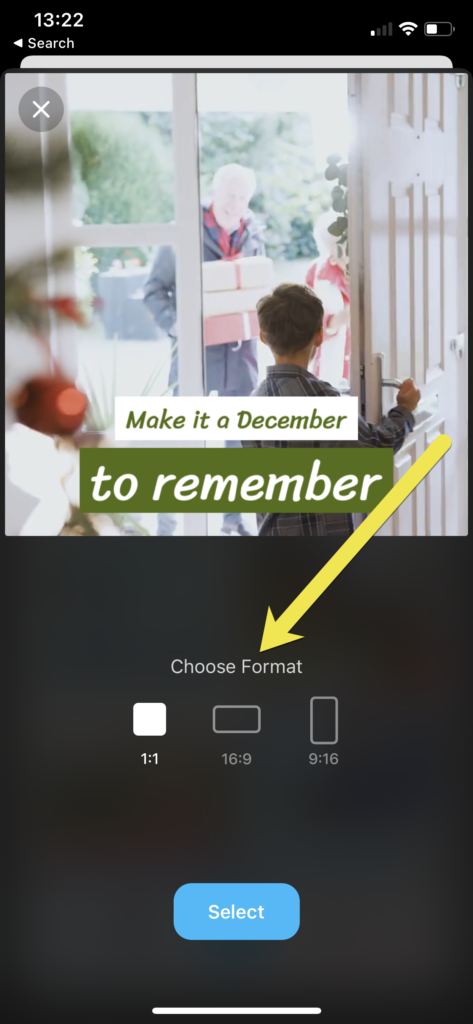
Source: Screenshot created by the author
This way you can create content assets that will fit all of your channels. There’s also a handy Brand Kit feature allowing you to maintain a consistent visual identity throughout all your assets:
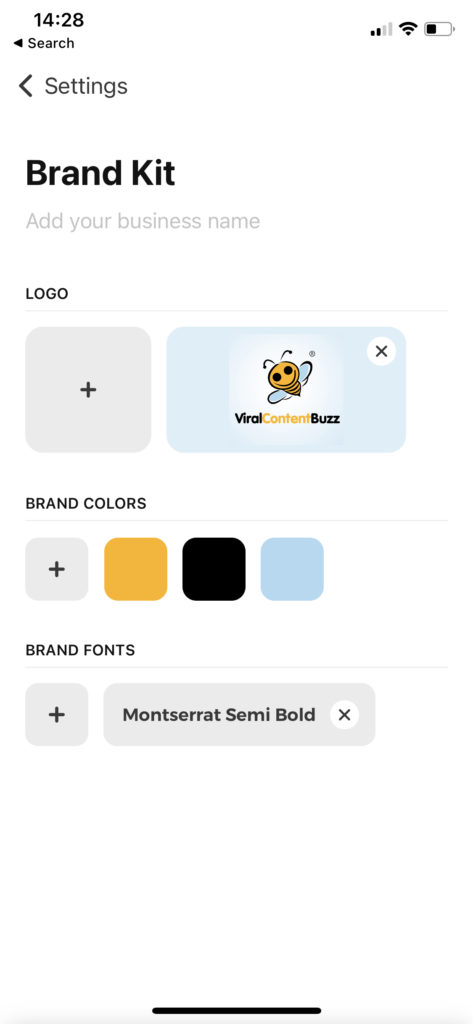
Source: Screenshot created by the author
The app is available on iPhone and Android for free. You can choose to upgrade for $4.99 per month. I for one have been using the free tier (and the above screenshots are taken when using the free version of the app).
The platform also offers a list of seasonal content ideas and hashtags to make your campaign even more effective.
There are a few more video creation apps out there but I don’t think any of them let you access so many great features for free.
Another great content creation tool that gives you lots of free features for free is, of course, Canva. I’ve been using Canva for free for as long as I can remember without ever having to upgrade.
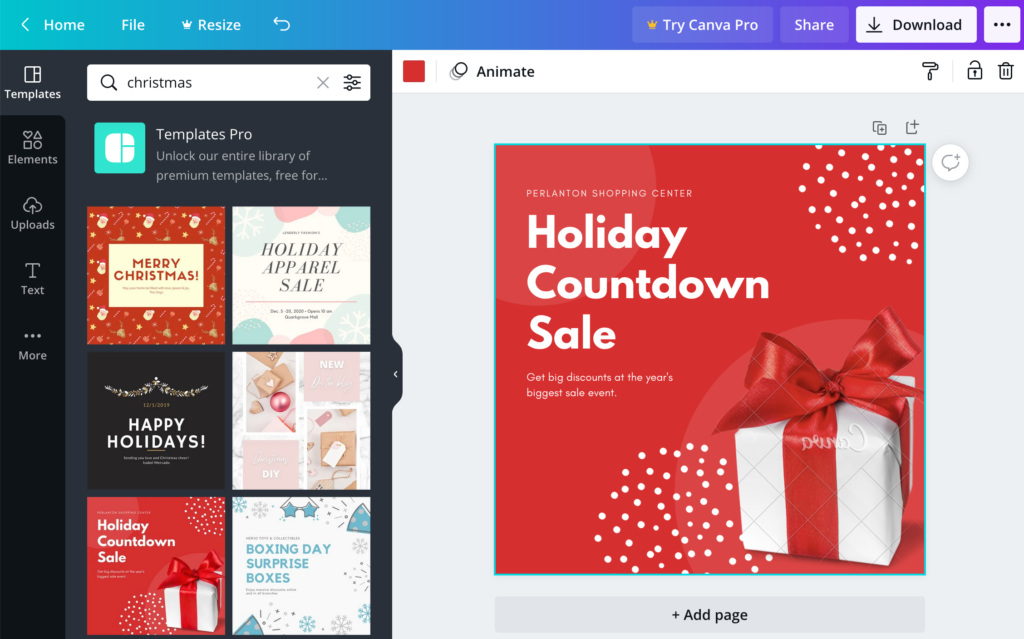
Source: Screenshot created by the author
Here’s the guide on planning a Christmas marketing campaign
If you were publicizing any seasonal content over the years, find all of it to:
Explore an opportunity for an update (“Can I reuse this asset this year?” as well as “How can I make it better?”)Evaluate how effective it was in attracting traffic as well as turning those clicks into conversions
Google Analytics offers an easy way to identify landing pages that did the best job attracting traffic during any period:
Go to the Acquisition report and select one channel (for example, “social” or “organic search”)Select the date range of your seasonal campaign from the last year(Optionally) Check the box “Compare” and select “Previous year” from the drop-downClick “Landing page” tab in the chart below:
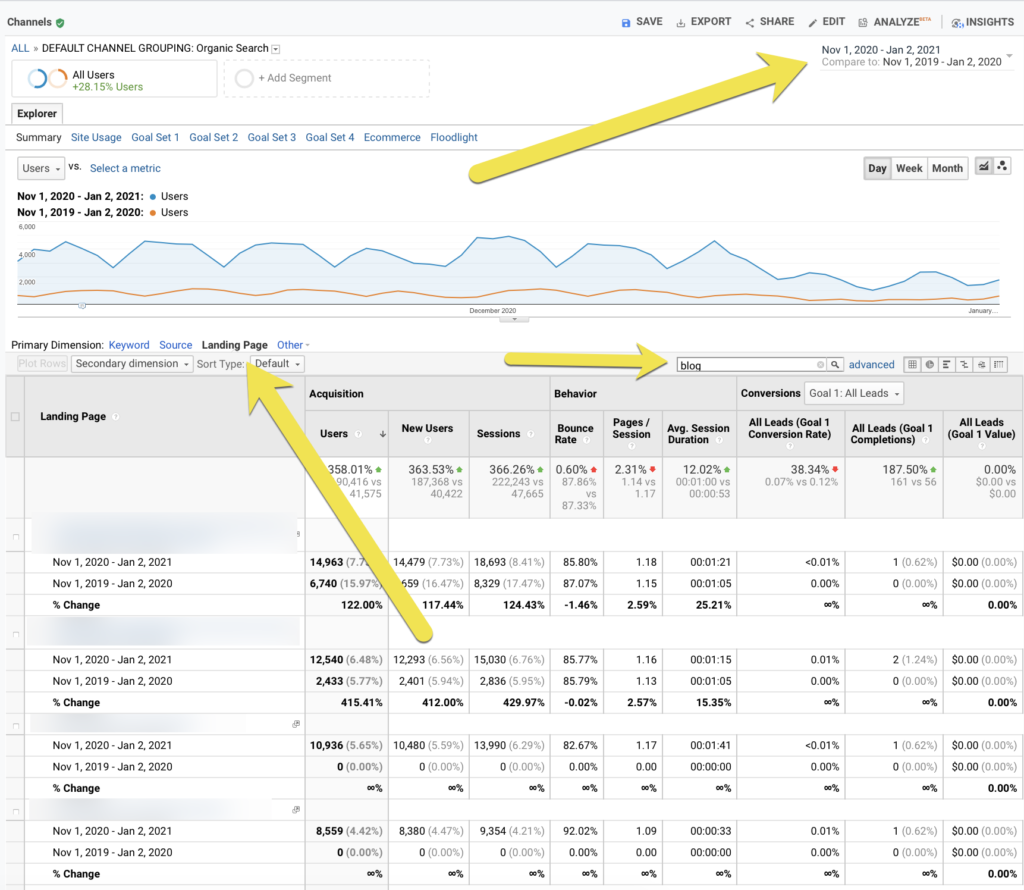
Source: Screenshot created by the author
This gives you an at-a-glance report of the highest traffic page from your previous campaigns. You can further narrow it down by using word filters (for example, type “blog” there to see your best performing seasonal content).
To analyze conversions, you can use Google Analytics goals and funnels. Another tool I am using to closely monitor incoming traffic and its conversions is Finteza. Because it makes it incredibly easy to narrow the data down to identify which traffic source is sending traffic and how well it converts as compared to other pages.
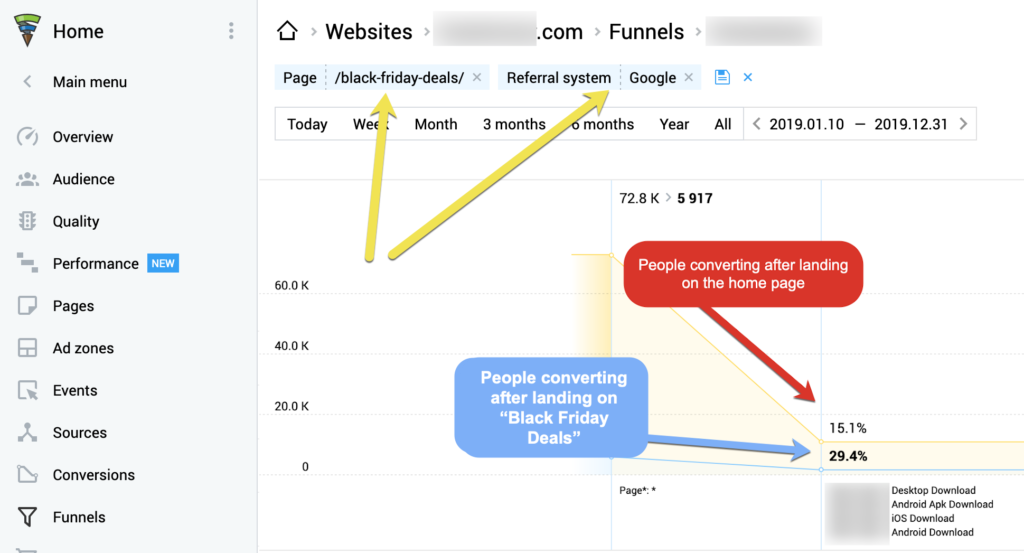
Source: Screenshot created by the author
Read more about Finteza’s conversion funnels here. Finteza costs $25 a month and there’s a 30-day trial available for you to play with the tool before committing.
If any of those previous content assets turned particularly successful, consider expanding that idea into a new project! We all remember the overwhelming success of “Elf YourselfAsk Santa, and NORAD mini-projects that were able to engage (and convert) thousands of people year over year.
A separate (single-page) site will be easier to brand and promote without causing any strong associations with your main business. If you need some inspiration, check out Namify:
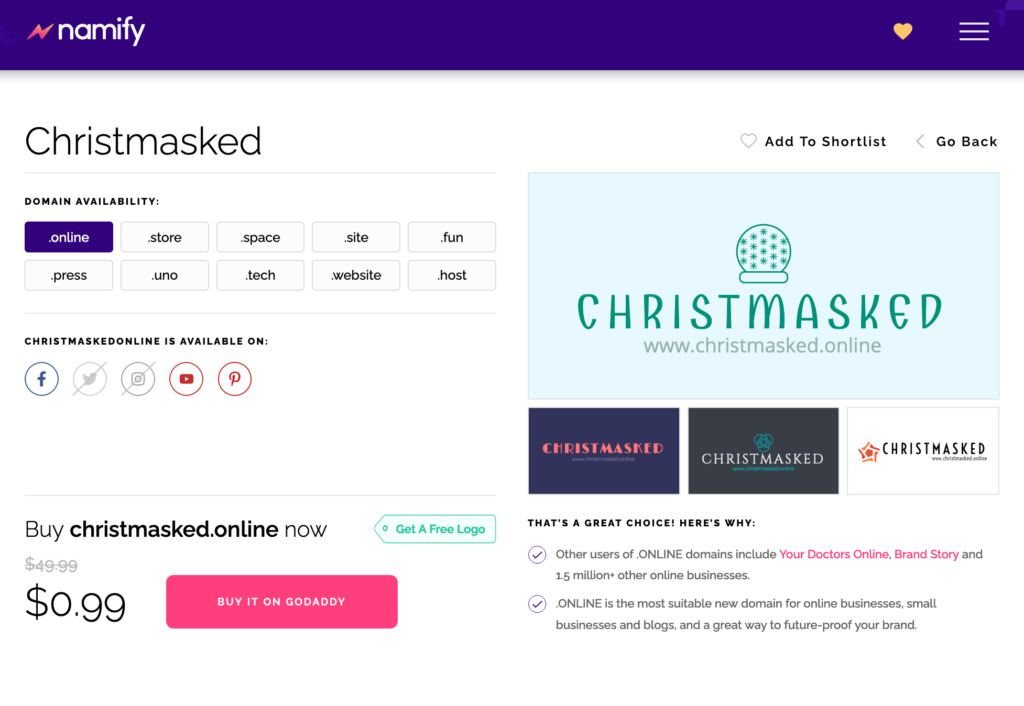
Source: Namify
Competitive analysis is important because it motivates a business owner to do more and do it better. Therefore I always include competitive analysis in any of my marketing planning.
There are plenty of ways to research your competitors and what they are doing. My first step is always checking Ahrefs and what other search queries they are ranking for:
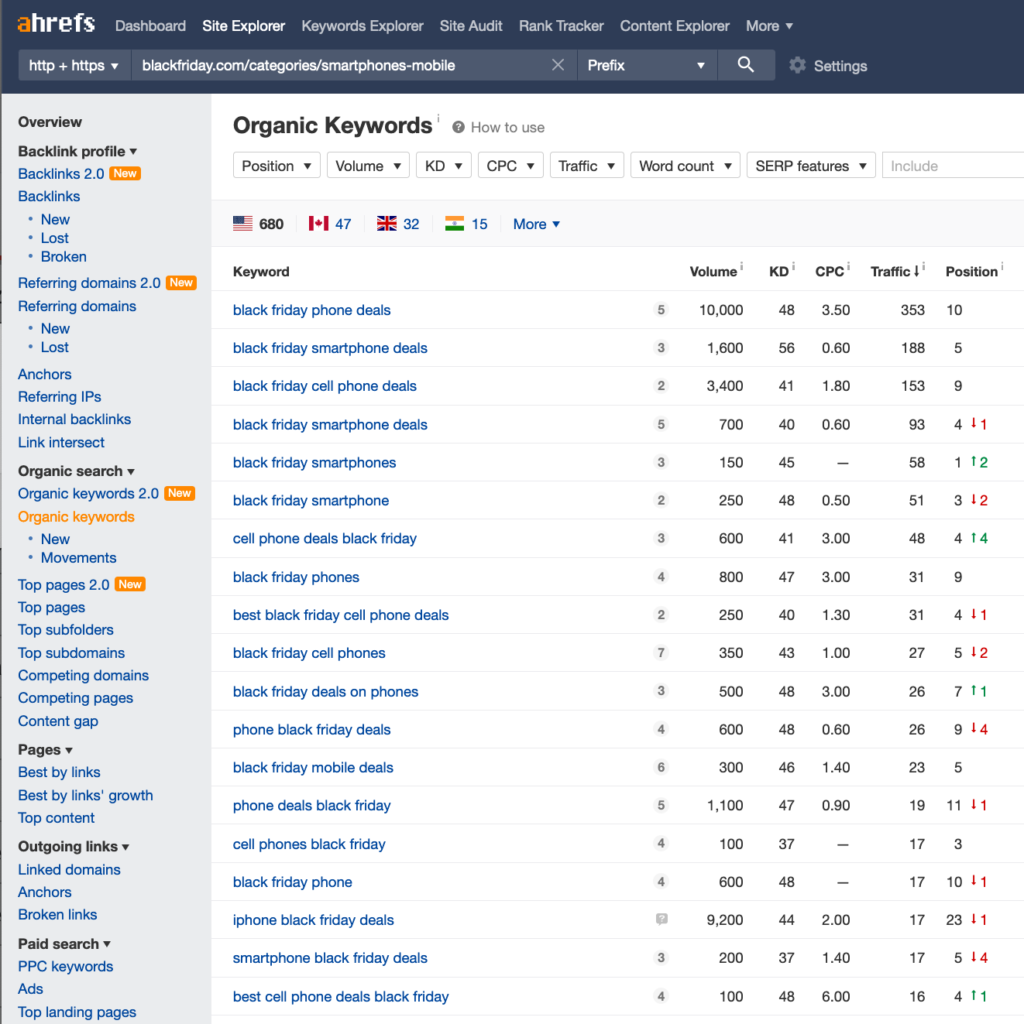
Source: Screenshot created by the author
Ahrefs is the only platform in the industry that also offers an estimate of traffic each search query sends. Here’s how they calculate it. Ahrefs lowest tier is $99 per month but it is definitely a must-have tool if you are doing SEO.
Similar Web is another nice tool for competitive research. I like looking at their “Referral Traffic” report to identify which sites are sending traffic to my competitors:
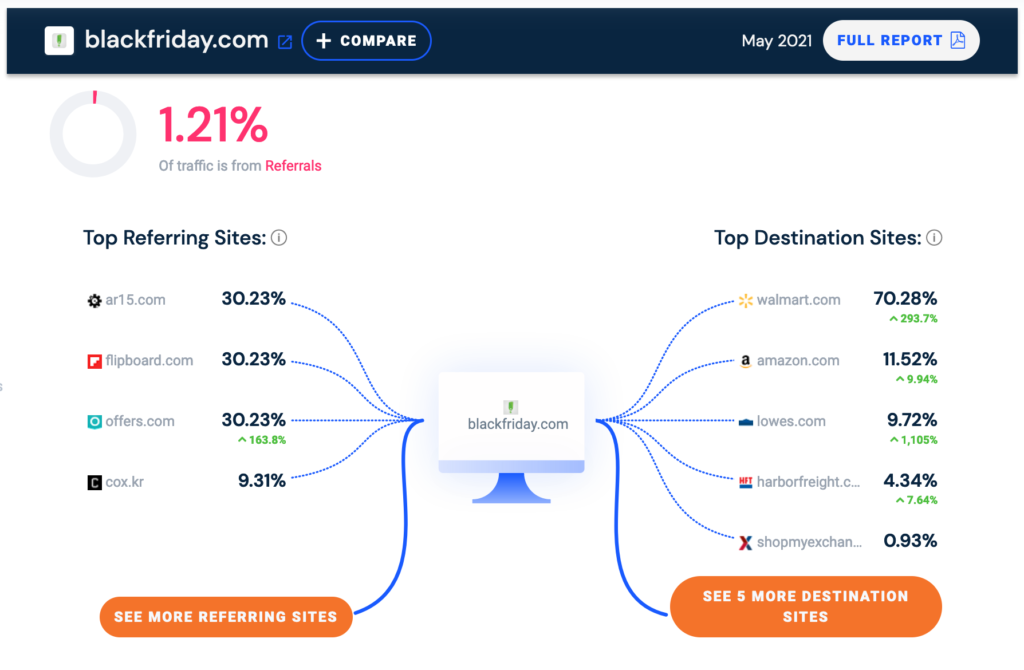
Source: Similar Web
This basic report is available for free.
It is also a good idea to set up Google Alerts to be modified when your competitors are doing something new.
Every year people seem to start preparing for big holidays earlier. It is not unusual to spot a Holiday-centric social media ad in October. This can actually cause both excitement and irritation.
So the important question remains: When should I start publishing seasonal content?
This may depend from niche to niche, so I always suggest typing your target seasonal search query into Google Trends
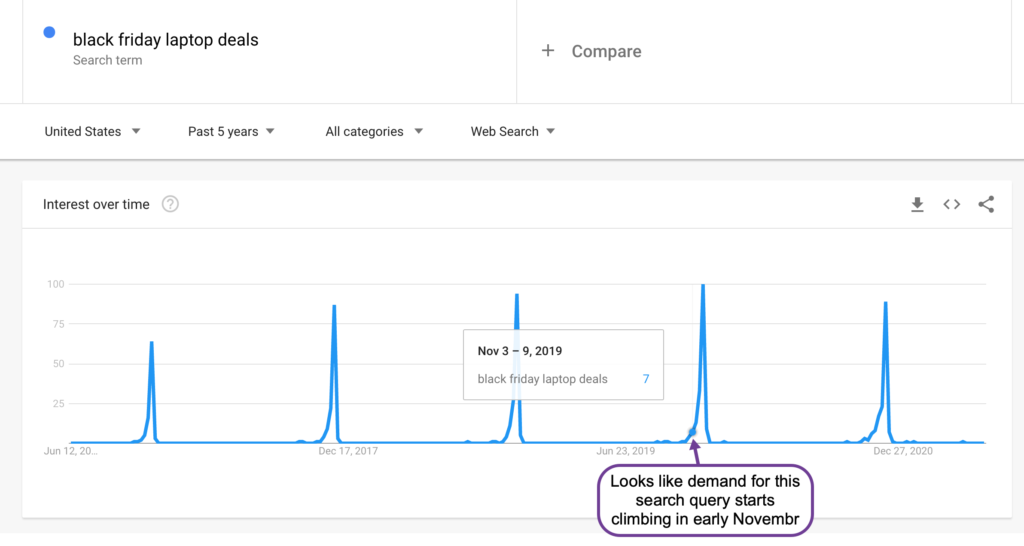
Source: Screenshot created by the author
It also helps to compare several of your target search queries. For example, in this niche the demand seems to be pretty consistent over the years:
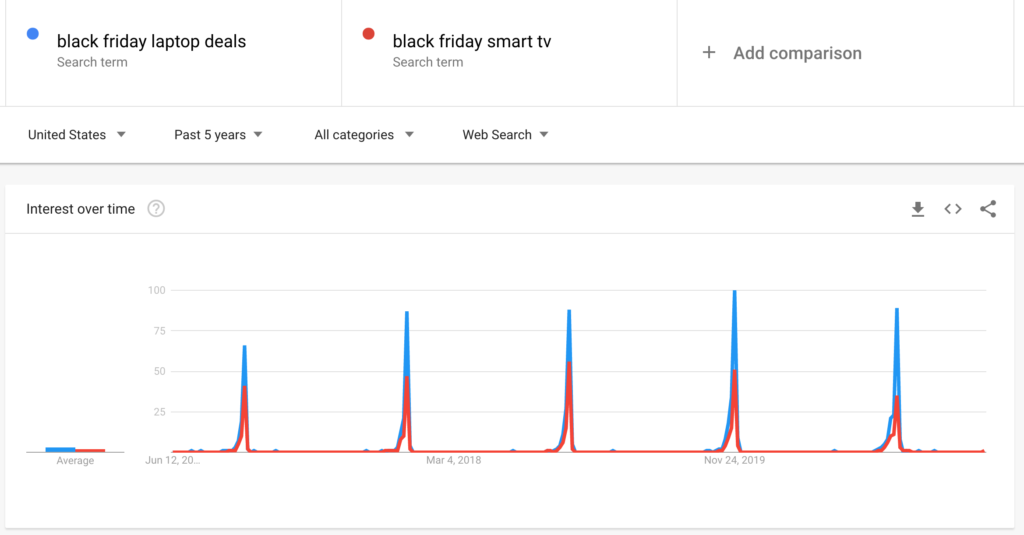
Source: Screenshot created by the author
When it comes to organizing and scheduling your content assets, there are a few great calendar plugins to choose from. I mostly use CoSchedule because it allows me to also schedule those updates to your social media channels as well as assign certain content assets to various contributors.
CoSchedule costs $29 per month. It supports scheduling to Twitter, Facebook, Linkedin, and Instagram. I prefer the tool because it combines on-site content planning (assigning content assets to be written) and social media scheduling. This allows me to create a very well-aligned content marketing campaign and makes it easy to organize editorial workflow across many channels.
Instagram also offers a helpful guide on planning your seasonal content strategy here
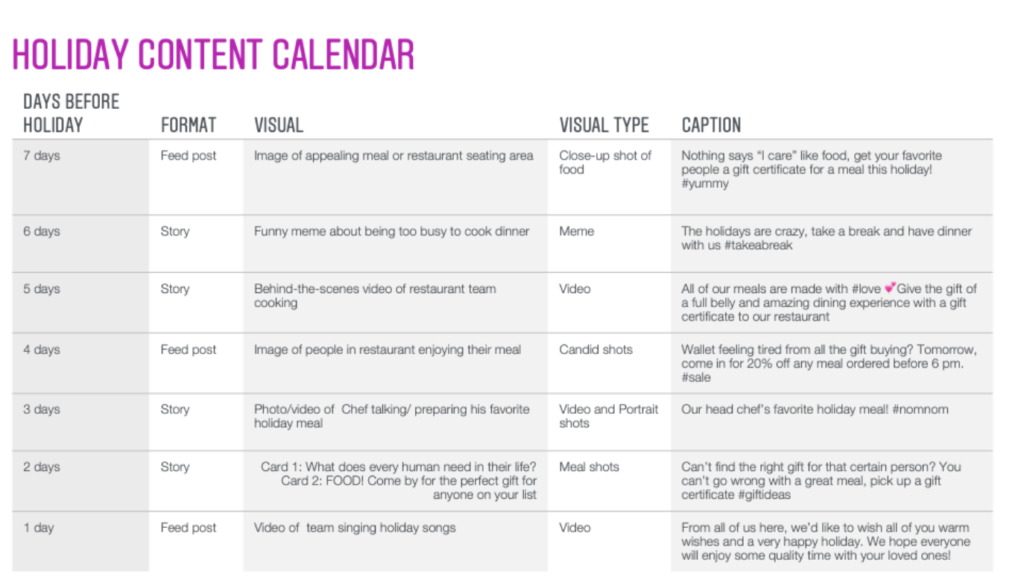
Source: Screenshot created by the author
Seasonal planning is a great way to make the most of those seasonal interest spikes and build more sales. The earlier you start preparing for your big season, the more time you have to handle an increased amount of sales. Good luck!
Ann Smarty is the Founder of Viral Content Bee, Brand and Community manager at Internet Marketing Ninjas. She can be found on Twitter @seosmarty.
The post Here’s how you can master your next seasonal digital marketing campaign appeared first on Search Engine Watch.


Google’s Multitask Unified Model (MUM) update landed in June 2021, seeking to deliver search results that overcome language and format barriers to deliver an improved search experienceThe Google MUM update uses an innovative solution that accesses a wealth of previously hidden information around a core query, providing more of what we want without having to carry out multiple different searchesGoogle MUM can understand and translates 75 different languages, including text and imagesMUM will see us bid farewell to BERT
They say Mum always knows best but can the same be said for Google’s MUM update? Giant search engine, Google, launched their latest update as the answer we have been looking for to make internet searching more intuitive and inclusive.
But what does this mean for website owners, SEO practitioners, and agencies providing marketing services?
The Google Multitask Unified Model (MUM) update, aims to answer modern search demands by using an AI-powered algorithm to improve online search capability. When searching the internet, contradictory to expectations users are faced with multiple searches, geographical, and language barriers due to a lack of intuition on the search engine.
Google’s MUM will remove the need to carry out multiple searches that users currently do in order to compare and gain deeper insights. It has the ability to understand and bring solutions based not just on textual content but also an interpretation of images, videos, and podcasts in a way that was never possible before.
It understands 75 different languages which implies that it can pool and serve results to give users the most holistic and comprehensive search experience, answering even the most complex queries.
Google MUM will redefine search relevance changing the way people accesses and use information across the world wide web. This however, needs to be taken with a pinch of salt that not all content can be trusted and would eventually boil down to user discretion.
The MUM update means searches will serve information that provides helpful, related insights, and will reach further for these sources than any other search engine update before it.
Google believes that the MUM update is the answer.
Although in its early days the algorithm will continue to see iterations but it certainly looks to be an exciting move that Google is committed to build on. How? Google intends to follow these in order to ensure they can make it “the world’s best MUM” and remove any machine learning biases:
Human feedback from raters using the Search Quality Rater Guidelines will help understand how people find informationSimilar to 2019’s BERT update, MUM too will undergo the same process applied to Google search modelsApplying learnings from their latest research on how to reduce the carbon footprint of large neural network training systems to ensure search continues to function as efficiently as possible
MUM interprets meaning in a people-friendly way, breaking down language barriers to provide us with the most comprehensive search engine capability ever.
It’s fast, far-reaching, and thorough as compared to any previous search engine update. This matters in a world where users want detailed, relevant, and accurate answers in seconds – anywhere, anytime.
This will remove silos in search dropping all the veils of language barriers and lack of intuition. It will view user queries, questions and comparison needs from all angles reducing the time we spend trying to find the right answers to elicit what we need.
For a long time, keywords and SEO content have been a critical part of how information is served and how it needs to match intent. Over recent years whilst this has remained important to draw attention to specifics, it has changed slightly to be more phrase friendly, finding keywords used in a more natural context. This certainly benefits the MUM search algorithm. It can provide nuanced answers to questions, using NLP, and in-depth world knowledge to gather additional information supplements by a mix of formats – text, images, or even video and audio in the future.
Its ability to think beyond the question or statement will tap into multiple dimensions of the SERP and SEO as a result. Users, businesses, and content creators are being encouraged to say goodbye to the “exact response days” and tap into the user intent and journey that is layered, complex, and sometimes more generalized.
Google MUM’s AI smarts will be another piece in mastering and understanding user intent and thought processes.
Imagine wanting to travel to a country and the questions you currently have to ask to find all you need to know. Firstly, you might wonder how you get there. Then you may search for where to stay, what’s in the area, for visas or vaccinations required and perhaps a bit about the weather and activities available. The list goes on and so does the time taken to search and sift through results.
We now want more, right away, and Google MUM is the beginning of meeting these needs.
MUM will find results in other languages, opening up a treasure chest of local and more insightful information than any previous Google search technology has ever offered. It aims to become your very own expert and translator, with the added value that you can expect from an enthusiastic human – succinctly delivered, plentiful detailed, and readily given in a language you understand, just like engaging with a human expert.
Searches are no longer inhibited by the words we choose. People can elicit more specific answers to questions by including an image, video or web page in our search. This ensure greater access to international content that previous search engines would not have recognized.
This breaking down of language barriers will allow users, SEOs, and businesses to see more localized insights and responses. On the SEO and digital marketing front, this also means – more competition! Local people create many reviews on areas or facilities, yet we currently miss what could be the best answer to our review style questions due to language barriers.
Unless users search sufficiently and widely using local terms, spellings or language nuances, they never discover pieces of information that would be an integral part of decision making.
While MUM will know it all (hopefully) since it uses the T5 text-to-text framework and is 1,000 times more powerful than BERT. We will still see answers to straightforward questions. But the ones that are less simple or don’t have a straight answer will flourish with this multi-modal approach. Imagine, what if the answer lies in an image that could be in Japanese?
I and the search engine
Search engines have driven the way content is created, focusing heavily on keywords, phrases, intent, and other key factors. So should AI change how businesses, SEOs, and agencies think about attracting visitors and engaging them while ensuring we use the exposure Google MUM can offer? This is a far greater intelligent search algorithm that understands nuances and will bring more relevant and varied content to the fore.
Content that is wrongly pitched will disappear more readily than ever before. This reinstates how important the user experience, content, overall SEO, accessibility, and intent are for success in the age of digital. Content must, therefore, be better than a few placed keywords to make it anywhere in page rankings and it must make optimal use of multimedia formats that Google MUM looks at. End-users are MUM’s focus and that must be at the front of how content marketers work. This is important to remember when considering redesigning your website. We see it reinforcing the need for quality SEO and key phrase content if you want to be noticed.
Google MUM has a far greater ability to answer comparison style questions too.
“Will I find the same weather in Turkey as Egypt?” style questions will bring answers in one go. Previously we would have to dig around the information for each country and compare information ourselves. Not only will one question suffice to elicit temperatures for each, but it will offer added value information on each country that it knows people may have gone on to search. It may include relevant comparisons between the two countries, such as vaccinations or visa information, dress codes or helpful information that its AI capability recognizes as appropriate.
Like every launch, the latest proclaims to be the best. BERT (Bidirectional Encoder Representations from Transformers) was launched in 2019 and understood searches better than we have ever been able to before. Around this time, keywords became key phrases seeking to provide results based on user intent. In other words, content had to answer common questions.
Numbers tell us that MUM is 1000 times more powerful than BERT, so will MUM always know best? It undoubtedly would seem that this changes the face of search and SEO as we know it in 2021.
Create content that remains high quality and focused yet opens up the possibilities that tangential linking can bring to comparison and related topics. Content must answer questions and provide the right level of added value, including appropriate use of multimedia formats so that MUM will notice you. Written content, including blog posts and articles, is still a key player in attracting attention. There is increased importance on backing this up with podcasts, images, audio, and video content – this would help when MUM’s new iterations come into play.Google MUM will know it is relevant and add it to search results. Your content will now compete amongst the most significant contributions around the world. While it removes language barriers, it would still be wise to have multi-lingual SEO as part of your strategy. This will dramatically affect the regional power of content, so use it to your advantage, ramping up regional relevance, neighborhood interests, or specifics both verbally and visually.Produce content that builds brand recognition and loyalty using informative, engaging writing, images, and other media. Remember to add structured data to your page to give clues about the content. Brands and advertisers need to be mindful that this is an AI-centric update and would learn as it goes. We know that whilst Google MUM will widen search answers, there will always be people that know where to look and who to rely on for trusted content, so the expanded pool of SERP competition will not typically minimize your current audience as long as you continue to remain reliable. Bottom line is – Continue to build your expertise and authority in the industry so you can ‘EAT’ your competition.
In all honesty, with fewer tricks to hide behind, what you need to make sure of when creating MUM-friendly content simply translates to quality. If it is interesting, relevant, and valuable to your end user, then it will be seen. It will widen the potential audience and bring more significant competition for visibility, and that is just as likely to be a good thing as bad for many.
Are we genuinely heading to an internet-driven world without barriers? While Google’s MUM seeks to understand more about what we might be looking for than any search engine has ever before, will this open up the search-scape to a truly more worldly experience? We can’t answer all the questions and there are many still to be asked as the rollout gathers pace. Only time will tell us how Google improvise MUM in the future. After all, technology and innovation never stand still for long.
Joe Dawson is Director of strategic growth agency Creative.onl, based in the UK. He can be found on Twitter @jdwn
Subscribe to the Search Engine Watch newsletter for insights on SEO, the search landscape, search marketing, digital marketing, leadership, podcasts, and more.
Join the conversation with us on LinkedIn and Twitter.
The post Everything you need to know about the Google MUM update appeared first on Search Engine Watch.

Following pandemic-driven shopping trends, lots of local businesses had to explore online marketing opportunitiesGoogle offers a few great ways for a local business to get found through organic searchLocal 3 Pack is Google’s search element containing top three local businesses based on your search query.To rank in the Local 3 Pack you need to ensure your Google My Business listing is complete and activeThird-party local business listings (like Yelp and Tripadvisor) may also drive some organic search visibility so it is a good idea to claim your business thereHyperlocal content may help your business discovered by people who were not even searching to buy a local product or service, so produce relevant content on a regular basis
Local marketing has become even a more trending topic, following the pandemic-driven pandemic.
Lots of local businesses that used to rely on local foot traffic were forced to turn to the Internet to get found by customers.
That digital transformation brought this huge challenge to just about any local business – how to get found online.
Google offers huge organic search visibility to local businesses through the so-called Local 3 Pack that shows up on top of organic results when search intent reflects buying (or doing) something locally.
Local 3 pack is Google’s search element that includes three relevant businesses from Google Maps results:

Image source: Screenshot by the author
Ranking your business in the Local 3 Pack is no easy task. It heavily relies on proximity of those businesses to the customer’s current location.
However, there are a few things you can do to improve your local rankings:
Make sure you have a detailed (and original) description of your business and what it is you do.Add your website (oftentimes Google would grab text from the associated website and rank a business based on that content). There are also a few great plugins allowing you to embed your local listing onto your website for better visibility.Upload pictures and videos of your office and teamAdd your products and services (Note: Services are not believed to have a huge (or any) impact on your local rankings but why not add those anyway)Your business categories. Keep those categories as relevant as you can as they can harm your local rankings
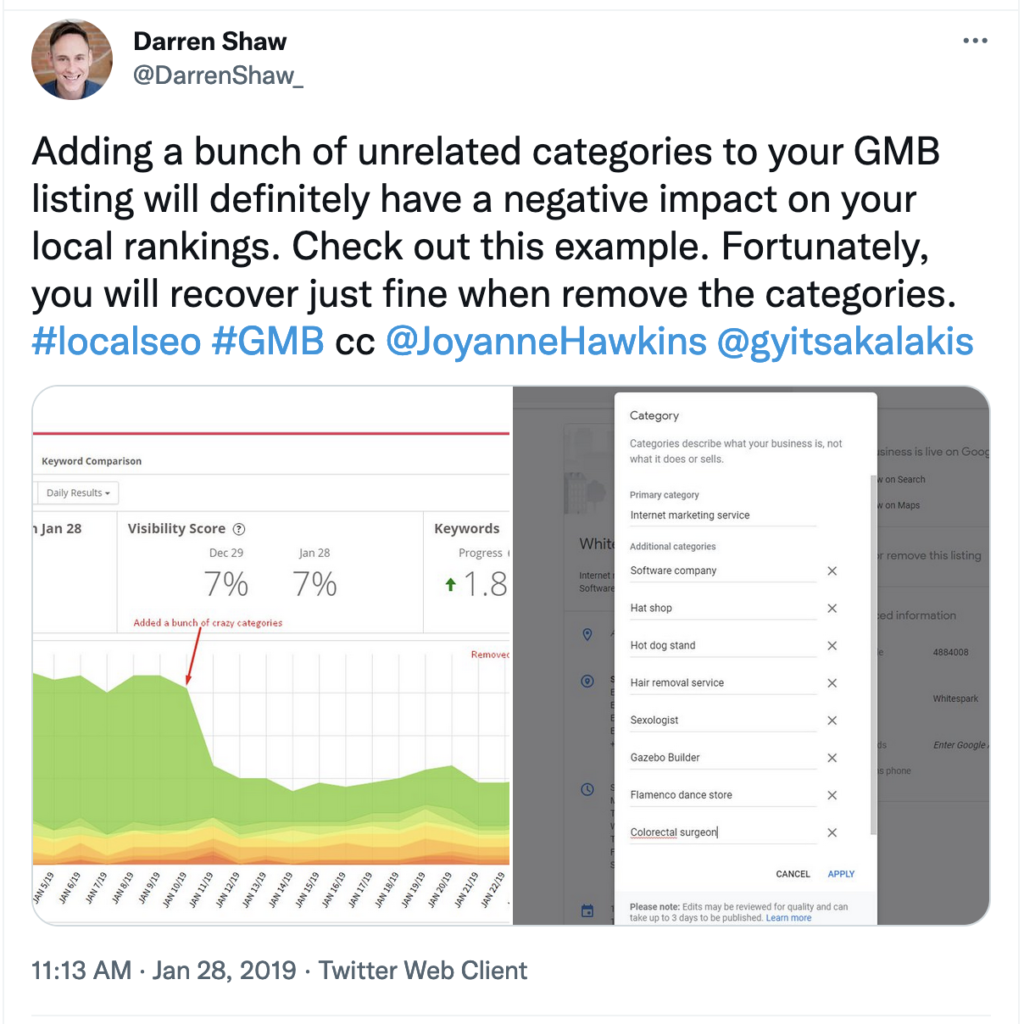
Image source: Screenshot by the author
Business reviews are known to be crucial for your local (and hence Local 3 Pack) rankings, so make sure to keep an eye on your reviews and reply to all of them.
Note that Google may remove your review if they find you have been using manipulative or misleading tactics when getting those reviews, for example:
If that review is repeated across other business profiles on other sites (which, by the way, can be quite natural… I’ll be the one to admit that I may leave my favorite business the same review on a few platforms I am registered at. But again, I think we are talking about suspicious patterns here rather than one-on-one cases)If you had a massive influx of reviews overnightIf Google suspects that you and your team are reviewing your business pretending to be clients.
While you may notice your competitors implement these manipulative tactics without no obviously negative impact on their rankings, I’d still suggest avoiding these at all costs.
You can invite your customers to review your business on Google through ashort URL that’s specific to your local business (and even note that on your business card). But you are not allowed to request positive (five-star) reviews or segment your customer base to only invite happy customers to review you.
If you have a budget, investing in ads on Google maps is also a great idea. This could bring in more customers and reviews.
While claiming your business is generally a good idea to get better control over your branded content, it also gives you additional organic exposure because those listings may rank in organic search results and bring additional exposure.
Hence, your next step is identifying important local directories (like Trip Advisor and Yelp)and claiming your business everywhere.
Here’s a huge list of those you can consider.
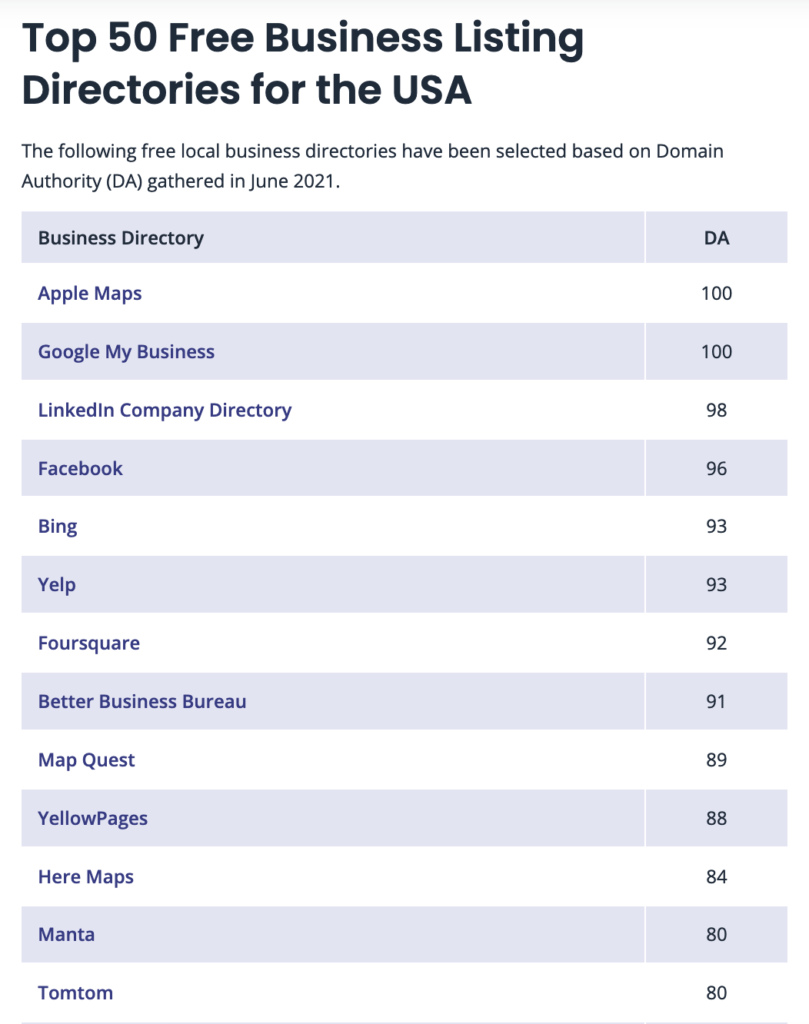
Image source: The Ultimate Free Business Directory List for the USA – Updated 2020
Just about any local business out there will need to ensure a strong Yelp presence, for example, so that one will always be on top of your list. Yelp marketing is tricky but if you start getting reviews there, there’s a way to display those reviews on your site to boost your conversions.
When putting your business on maps…
Make sure your business name and address is consistent across all channels, including the phone number formatComplete all available fields and use all available characters! More content generally means higher rankings for your listings!Monitor your listings for reviews, add updates, ensure your info is up-to-date!
Similar to how foot traffic works for a local business (passers-by may check a store out of curiosity), a well-planned content marketing strategy can drive customers who never intended to buy anything or didn’t know they needed you.
Describe (location-driven) problems your business solves. For instance, a Seattle hairdresser publishes an article on haircuts that work well in the windy or rainy climate.Address some problems that are common in your area. These work best when they are timed to a particular seasonal trend. For instance, a bakery in Albany publishes a checklist of foods to store at home to prepare for a snowstorm.
Here are a few ideas for hyperlocal content:
Ideas for local vacations and where your business can be of helpLocal events and how your brand participatesLocal partnerships like local charities
Take note of local People Also Ask results because those are great sources of hyperlocal content.
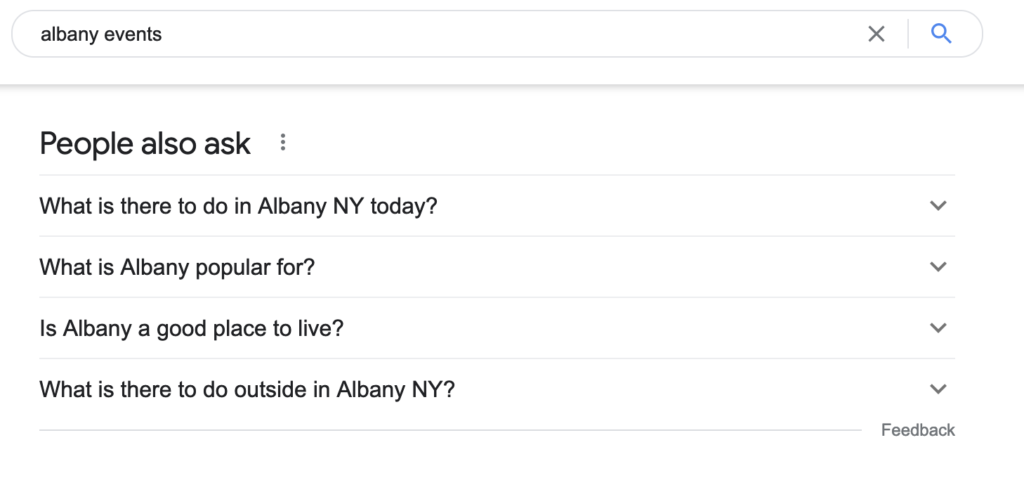
Image source: Screenshot by the author
Generally, answering local questions is a great idea!
Let’s take a look at this search query: “how far is Central Park from Times Square
People searching for this may not necessarily be looking to buy anything but there are still some opportunities here as your content may give them ideas on where to dine or stay.
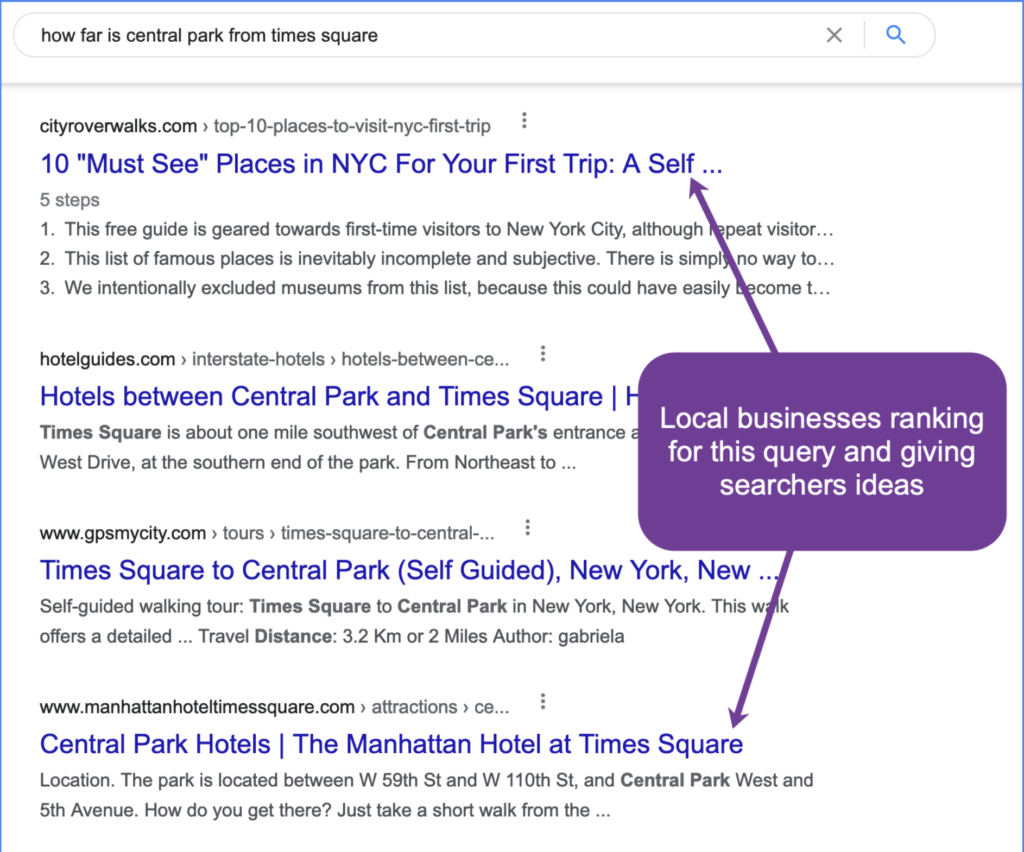
Image source: Screenshot by the author
The beauty of hyperlocal content marketing is that your clients don’t have to be in the area to find your content: They may be planning a trip to your area and discover your business prior to going. This is something local maps placement won’t be able to help with.
Using semantic search is another good way to come up with hyperlocal content ideas because it will help you identify location-based keywords that are able to generate organic traffic. Here’s how semantic search works:
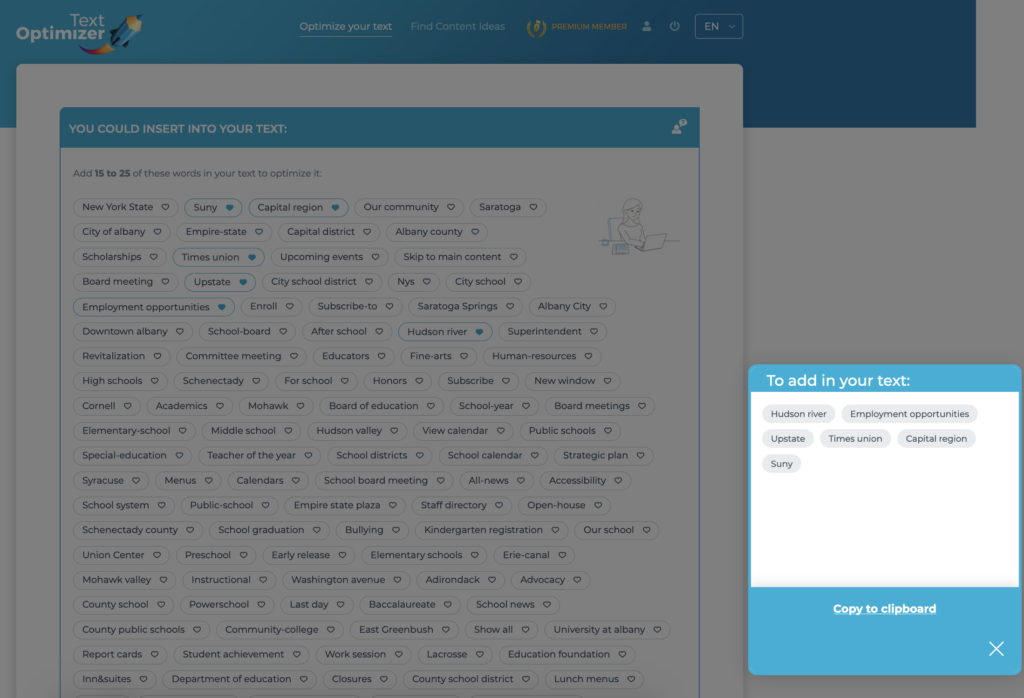
Image source: Screenshot by the author
Organic search provides quite a few opportunities for local businesses to generate traffic and get found by customers. Keep an eye on your local listings and keep creating hyperlocal content to generate relevant traffic for your local business. Good luck!
Ann Smarty is the Founder of Viral Content Bee, Brand and Community manager at Internet Marketing Ninjas. She can be found on Twitter @seosmarty.
Subscribe to the Search Engine Watch newsletter for insights on SEO, the search landscape, search marketing, digital marketing, leadership, podcasts, and more.
Join the conversation with us on LinkedIn and Twitter.
The post Three organic search opportunities for your local business appeared first on Search Engine Watch.

The PageRank still exists and here’s a deeper look at how Google’s Reasonable Surfer Model plays a key roleA well thought linking strategy both internally and externally for your ecommerce site can amplify search visibilityGoogle expert, Susan Dolan and Founder of leading agency NOVOS, Samuel Hurley share an ecommerce SEO guide ahead of the holiday season
PageRank is a patent Google introduced, which used links to help determine websites rankings in the SERPs. The algorithm was named after Google founder Larry Page.
The original patent has not been renewed and has since been updated by other algorithms, which work to achieve the same goal. However, by understanding the fundamental principles, we can better understand how to position our eCom sites to drive traffic and revenue.
PageRank is passed between websites through links and can be distributed through a single website with internal links.
Some pages have a higher PageRank than others and thus can pass on more PageRank to pages they link to. When a page links to another, a dampening factor is applied. The original patent set this as 0.85 – so a page with a PageRank of one, linking to another page would pass 0.85 PageRank.
Google’s Reasonable Surfer Model indicates that a link that is more likely to be clicked on will pass more PageRank than a link that is less likely to be clicked on. This is determined by a whole host of factors, including font size, color, and anchor text. However, the position of a link on a page is also something that we often have control over as SEOs and that we can, therefore, leverage.
Here is a simple, rather crude representation of how certain links will pass more/less PageRank based on the prominence of a link and how likely it is to be clicked on.

As linking pages pass PageRank, it stands to reason that we want to generate backlinks to key pages that we want to rank. For most ecommerce sites, the pages that rank for the highest volume and most revenue-driving keywords are category pages.
Wherever possible, we should therefore look to use tactics that support link building through to the pages that drive revenue, which for most sites looks something like:
Category pagesProduct pagesHomepageBlog posts
This is obviously easier said than done. Practicing these tactics with an overall aim to drive PageRank to your key pages. This reduces the dampening factors at play.
One common way to bypass this difficulty in building links to category pages is internally linking to key category pages we want to push from blog posts/Digital PR pieces that then get links themselves.
Although the PageRank passed to the page we ideally want to rank will undergo a dampening factor, this can still be more beneficial than failing to get any links at all to your target page.
It is worth considering how relevant the category page is to the blog/PR piece it is being included on, as well as where the links are placed on the page, being mindful of the impact the Reasonable Surfer dampening effect can have.
As any Digital PR will know, high authority pages or pages that have lots of PageRank to pass onto your own site are some of the most sought-after links to attain.
Most of the time, this is actually viewed at a domain level, however as is demonstrated in this great review of how PageRank works by Majestic, a domain that should theoretically have a high PageRank can actually be significantly decreased at a page level by its own internal linking.
One caveat for Digital PR teams in this regard is not being too reliant on domain-level metrics as a proxy for links that pass a lot of PageRank and are thus good for ranking. Exactly which pages have high PageRank is nigh-on impossible to know, and although an over-reliance on third-party tools is never optimal, they may be the closest we can get to figuring out PageRank passed by a specific page, rather than a domain.
As part of the Reasonable Surfer Model, it suggests that a link is less likely to be followed if the links are unrelated to the document:
“This reasonable surfer model reflects the fact that not all of the links associated with a document are equally likely to be followed. Examples of unlikely followed links may include “Terms of Service” links, banner advertisements, and links unrelated to the document.” (Source)
As a result, building links from sites that are of higher relevance to your own site, is likely to pass more PageRank.
Due to how PageRank is calculated, the PageRank value passed by one site can be drastically higher than the PageRank passed by the culmination of 1000s of others combined.
This is why the reliance on the overall number of links can be misleading.
We need to consider a few different methods while identifying pages that will benefit the most from ranking and how you pass PageRank around an ecommerce site:
Link to pages you want to rank from pages that have high PageRank themselvesLink to pages you want to rank more frequently throughout the siteGive links to pages you want more prominently ranked
Pages that have high PageRank, from which we can assume to be the pages most linked to from external sites, can be used to pass PageRank to –
The best example of how you can do this is through the homepage. The homepage for most websites tends to be one of the most, if not the most externally linked to page on a site.
This means that in terms of PageRank, the homepage has the most to pass on to other internal pages.
By carefully selecting which pages you link to from the homepage, and therefore pass the high levels of PageRank to the key pages you want to rank.
Another method to consider is how frequently you link to the most important pages you want to rank.
Considering that each page can pass PageRank on – this stands to reason that if a page is internally linked to more frequently, it is likely to pass on more as compared to a page less internally linked to (although obviously influenced by the PageRank of the linking pages).
Therefore, you should be considering where you can add internal links to ensure that important pages are linked to more frequently, including:
Due to being outside of the main body content of the page, we can reasonably assume there is a dampening factor applied to links in the menu. However, given its role in navigation, this is likely to be far less than in the footer.
Therefore, since the global navigation is, as the name suggests, linked globally from every page on the site, the sheer number of links that will be passing PageRank is likely to funnel to those pages included in the navigation. These should therefore be the key pages you want to be ranking.
As long-time fans of breadcrumbs at NOVOS, their benefit of passing PageRank to key pages should not be underestimated, due to the frequency with which different levels of pages are linked to.
The benefit of breadcrumbs on ecommerce sites (outside of usability benefits for the customers) is that they pass PageRank up to the core pages that generally rank for competitive keywords. They are typically helpful to rank the categories.
Most ecommerce websites have a pyramid structure with the homepage at the top, followed by some core categories, an increasing number of subcategories, and lots of product pages. By implementing breadcrumbs on the site, you use the pyramid structure to your advantage (both SEO and CX wise). Since every product page will link up to its relevant subcategories and category, and every subcategory will link through to its relevant category.
In this sense, you distribute internal links as an inverse pyramid, concentrating the highest number (if we disregard the homepage) on the core categories that are the pages generally targeted for high volume keywords. In this sense, your ecommerce site stands a great chance of receiving large amounts of PageRank from internal links.
Product pages also generally are easier to build links to and also naturally generate them. The higher PageRank product pages can distribute upwards, the greater is the relevance – which implies lesser chances of suffering significantly from dampening factors.
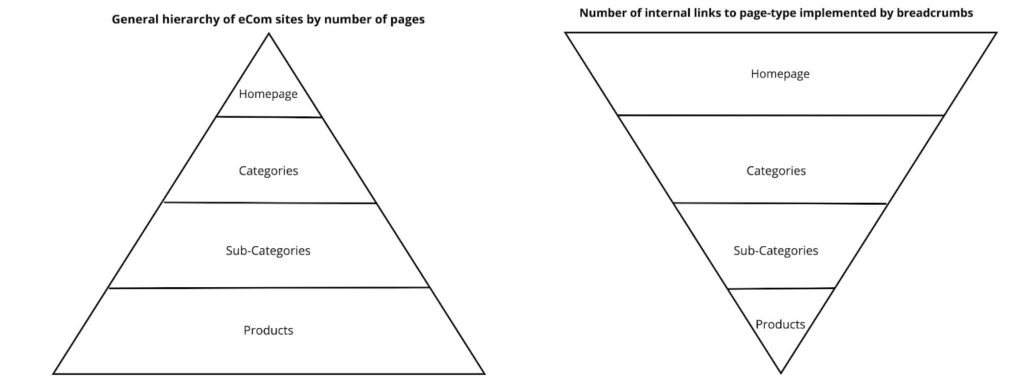
Based on the Reasonable Surfer Model we can assume that the PageRank passed by footer links is significantly impacted by dampening factors. However, the fact that these links are site-wide may mean that there is some benefit to including important pages in the footer for the accumulation of PageRank.
As the Reasonable Surfer Model applied to the likelihood of a link being clicked on a page, it is therefore worth considering whereabouts on a page. This could also mean considering page templates in general links.
For example, in a content strategy, where multiple blogs are being written on a given relevant topic to support a category page, linking to the category page early in the article, with clearly related anchor text, is likely to drive more PageRank than right at the end of an article. On a case-by-case basis, this distinction may appear trivial, however, on an ecommerce site with hundreds and thousands of blogs, the PageRank passed in total may be significant.
Susan Dolan is a Search Engine Optimization Consultant first to crack the Google PageRank algorithm as confirmed by Eric Schmidt’s office in 2014.
Samuel Hurley is the Founder of NOVOS, Global SEO Agency Of The Year 2020 and 2021.
Subscribe to the Search Engine Watch newsletter for insights on SEO, the search landscape, search marketing, digital marketing, leadership, podcasts, and more.
Join the conversation with us on LinkedIn and Twitter.
The post How to use PageRank for ecommerce websites appeared first on Search Engine Watch.
Did you miss our previous article…
https://www.61seoservices.com/?p=55